






by John Ferrannin
It’s been a little over a month since Mayor Daniel Lurie was sworn into office. Some LGBTQ residents received a progress report when two individuals tasked with making San Francisco’s government more effective discussed how their efforts are going thus far at a meeting of the Alice B. Toklas LGBTQ Democratic Club.
Gay Board of Supervisors President Rafael Mandelman, who as District 8 supervisor represents the Castro LGBTQ neighborhood on the board, was joined by Aly Bonde, policy adviser to Lurie, at DECANTsf at 1168 Folsom Street, itself a queer-owned business. The February 10 panel – “Re-imagining San Francisco government” – was moderated by Nicole Neditch, the governance and economic policy director for SPUR.
Mandelman became the board president the same day Lurie was sworn in as mayor on January 8. The most senior member of the board, elected the same day as former mayor London Breed in 2018, he and Bonde agreed a new wind of cooperation is blowing through City Hall.
“A solid minority, if not a majority, of the Board of Supervisors was not interested in helping her administration,” Mandelman said of the relationship between the Breed administration and the prior board. “It was kind of mutual. ... There was this low regard between the mayor and the Board of Supervisors.”
(Breed herself was a former moderate supervisor and had to work with a progressive dominate board. Last November’s election, however, saw several new supervisors elected, most with more moderate political leanings.)
In contrast, Lurie, who had never held public office before winning the mayor’s race, avoided political conflicts and was able to get to City Hall without bad blood between him and the people he needs to help implement his agenda.
“Daniel Lurie got himself elected and came in without owing anyone anything in particular,” Mandelman said.
Bonde agreed that City Hall seems different from what she was expecting.
See page 8 >>

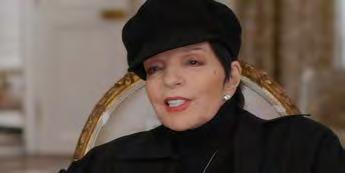

by Dana Piccoli
As of February 13, the word “transgender” has been removed from the Stonewall National Monument web page in Greenwich Village, New York. The site and monument, which are part of the National Park Service, also removed the “T” representing trans people, as well as the “Q” for “queer.”
The move comes a short time after the Bay Area Reporter noted that the San Francisco site of the 1966 Compton’s Cafeteria riots had been granted federal landmark status specifically for its connection to the transgender community.
The Stonewall National Monument honors the Stonewall Riots, which took place from June 28 to July 3, 1969, when transgender, bisexual, gay, and lesbian patrons of the Stonewall Inn pushed back against targeted harassment and police raids. The uprising has long been considered the beginning of the modern LGBTQ+ rights movement.
Trans and gender-nonconforming people, butch lesbians, and gay men were among those who led the rebellion, calling for better treatment and an end to anti-LGBTQ+ abuse. Notable participants include Marsha P. Johnson, Sylvia Rivera, Stormé DeLarverie, Miss Major Griffin-Gracy, Mark Segal, and Virginia Apuzzo, among others.
LGBTQ+ advocates spoke out against the removal of “trans” and “queer” from the site.




Writer and Gender Liberation Movement cofounder Raquel Willis posted on X, “The Stonewall Riots happened because of trans people, particularly of color, [who] rose up against state violence. You can’t even begin to tell the story without our ancestors and elders.”





Gay New York City Councilmember Erik Bottcher tweeted, “The Trump administration has erased transgender people from the Stonewall National Monument website. We will not allow them to erase the very existence of our siblings. We are one community!!”

by John Ferrannini
Castro denizens might soon be purchasing to-go drinks to party in the street during special occasions now that gay Board of Supervisors President Rafael Mandelman introduced legislation to establish a Castro Upper Market Entertainment Zone. The legislation, introduced February 4, would allow bars and restaurants to sell drinks for outdoor consumption during street fairs and other unique events held in the LGBTQ neighborhood.



The Los Angeles Blade covers Los Angeles and California news, politics, opinion, arts and entertainment and features national and international coverage from the Blade’s award-winning reporting team. Be part of this exciting publication serving LGBT Los Angeles from the team behind the Washington Blade, the nation’s first LGBT newspaper. From the freeway to the Beltway we’ve got you covered.
Mandelman, who represents the Castro as District 8 supervisor, said during the board meeting that “with its rich nightlife history, the Castro seems like a natural fit for an entertainment zone.”
“During COVID, San Francisco, like many cities, had to get creative in allowing more commercial activity outdoors,” Mandelman stated. “This was done out of necessity, but people also liked it.”
The proposal is expected to be heard by a supervisors committee in March.
The state legislation allowing for entertainment zones – Senate Bill 76 in 2023 and SB 969 in 2024 – allow local jurisdictions to designate outdoor areas where people can consume open containers of alcohol during special events, such
entertainment
See page 8 >>

for
as when streets are closed to traffic for street fairs or night markets. They were introduced by gay state Senator Scott Wiener (D-San Francisco), a Castro resident.
Reached for comment, Wiener stated, “I authored California’s entertainment zone law to

empower cities to make streets more vibrant and to support small businesses. It makes a lot of sense to create an entertainment zone in the Castro, and I fully support it.”

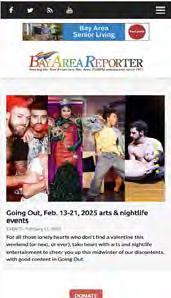
by John Ferrannini
The San Francisco Board of Supervisors unanimously approved legislation allowing some city leaders to fundraise for services on behalf of communities that might be negatively impacted by Trump administration policies, including LGBTQ San Franciscans. That could include raising money for legal services.
The February 11 vote was 10-0; District 10 Supervisor Shamann Walton was absent for that vote.
The legislation, a behested payment waiver, was forwarded to the board with a positive recommendation by the Government Audit and Oversight Committee February 6. Calvin Ho, a legislative aide to gay Board of Supervisors President Rafael Mandelman, explained that the city might have to file lawsuits to try to protect people’s constitutional rights.
“Our nation is in a state of crisis,” Ho told the committee. “Every day we hear new news and hear about ... efforts to strip away the rights of our trans community members and immigrant communities. I want to thank Mayor [Daniel] Lurie, City Attorney David Chiu and City Administrator Carmen Chu for their leadership in this moment, and [deputy] City Attorney Brad Russi for his work on this.”
The City Attorney’s office periodically sued President Donald Trump and various United States government departments during his first term. Since Trump’s return to power January 20, the city has already joined a suit against Trump’s effort to eliminate the 14th
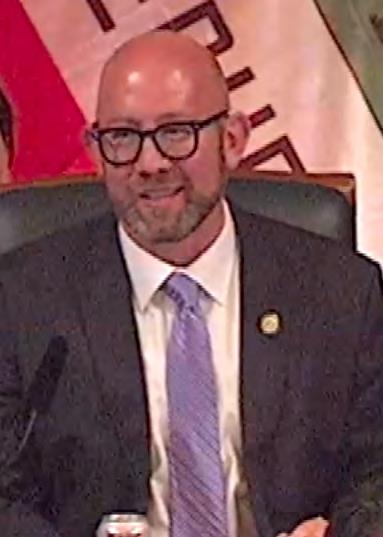
Amendment to the U.S. Constitution’s guarantee of birthright citizenship, and another suit over two memos the city alleges “instructed [federal justice department] personnel to investigate and civilly and criminally prosecute state and local officials in sanctuary jurisdictions who do not actively assist in immigration enforcement,” as well as Executive Order 14159, which the city says orders federal agencies to cut off funding to sanctuary cities, according to a news release from Chiu’s office.
The justice department recently brought a civil action challenging the city of Chicago and state of Illinois’ sanctuary laws.
“The Trump administration’s actions have nothing to do with public safety
because we know that sanctuary laws improve public safety,” Chiu stated in the release. “This is the federal government illegally asserting a right it does not have, telling cities how to use their resources, and commandeering local law enforcement. This is the federal government coercing local officials to bend to their will or face defunding or prosecution. That is illegal and authoritarian. As local officials, we have a right to do our jobs without threats and interference from the federal government.”
California state lawmakers last week gave final approval to set aside $50 million to fight the Trump administration in court. Gay state Senator Scott Wiener (D–San Francisco) and Senator Jesse Gabriel (D–Encino) authored legislation to set aside the money, which was approved by Governor Gavin Newsom, with similar concerns in mind. Wiener stated that “this funding agreement cements California’s readiness to serve as a bulwark against Trump’s extremist agenda.”
Gay Assemblymember Rick Chavez Zbur (D-Hollywood), formerly executive director of statewide LGBTQ civil rights organization Equality California, had championed the funds in the Legislature’s lower chamber.
“The administration in Washington has forced our hands. The President may betray his oath to uphold and defend the Constitution against all enemies foreign and domestic, but we cannot,” stated Zbur after the Assembly approved the funding measure February 3.
As the Bay Area Reporter previously reported, San Francisco school officials have already said they are standing by
policies to provide a safe learning environment for their LGBTQ students in spite of a Trump executive order that threatens to rescind federal school funds “that directly or indirectly support or subsidize the instruction, advancement, or promotion of gender ideology or discriminatory equity ideology in K-12 curriculum, instruction, programs, or activities.”
Mandelman stated to the B.A.R. February 8 the reason for the legislation.
“We’re doing this at the request of various electeds who want to be able to fundraise for important SF priorities,” he stated.
The legislation would allow the mayor’s office, the city attorney’s office, the office of the city administrator and the heads of each division, office, and department under the supervision of the city administrator to solicit donations from private, nonprofit, philanthropic and other entities for legal services on behalf of the city’s immigrant communities, related to defending LGBTQ+ rights, reproductive rights, environmental protection laws, and racial equity initiatives.
“It’s timely,” Russi said at the February 6 hearing. “What’s coming out of D.C. in the new federal administration is really unprecedented. The actions they are taking could have a significant impact on San Francisco and its communities. Our office tends to take all appropriate legal actions we can to uphold the city’s laws and values.”
The categories listed in the legislation were listed because it’s where the city attorney’s office anticipates the work will fall, Russi said.
“Our office has limited resources,” Russi explained. “We need to continue providing the legal services we always do for the city. We can’t undertake all this work without help from the outside.”
District 9 Supervisor Jackie Fielder, who is queer and chairs the board’s Government Audit and Oversight Committee, made successful amendments to the legislation during the process, such as one requiring the reporting of $5,000 or more at the request of an elected official.
District 2 Supervisor Stephen Sherrill, who also serves on the panel, said in the committee hearing, “I want to say how grateful I am to Supervisor Mandelman, Supervisor [Danny] Sauter and the rest of the co-sponsors of the resolution. I would like to add myself.
“We have to do all we can to fight for the residents of this city – especially those who are under attack: immigrant communities, LGBTQ+ friends and family, and our communities of color,” Sherrill continued. “We really need to equip our city attorney with every weapon at his disposal.”
Sauter, District 3’s supervisor, was the third yes vote on the committee February 6 to refer the matter to the full board.
On February 20, the government audit and oversight committee will hear a related piece of legislation authorizing the Assessor-Recorder’s to also solicit donations. Mandelman told the B.A.R. February 18 that “they are separate because the city attorney and mayor’s offices did their thing and the Assessor-Recorder’s office thought they could do something similar.”t
by John Ferrannini
State legislation to add new liquor licenses in downtown San Francisco will increase momentum to the city’s economic recovery, lawmakers hope.
The bill, introduced by gay state Senator Scott Wiener (D-San Francisco), would create 20 new liquor licenses in a new hospitality zone to cover the areas around Union Square and Moscone center.
At a February 18 news conference announcing Senate Bill 395, Mayor Daniel Lurie, who is sponsoring the state legislation, also committed to supporting an entertainment zone in the LGBTQ Castro neighborhood – the result of a separate measure from Wiener to allow alcohol sales for outdoor consumption at special times. (See related story.) It needs to be approved by the San Francisco Board of Supervisors, which is expected to vote on it next month.
“We’re going to work with Rafael Mandelman, board president on that,” Lurie told the Bay Area Reporter. “It’s in the early stages, but I’m very supportive and look forward to working with him on that.”
Mandelman represents the Castro as District 8 supervisor, in addition to being president of the board. There are already three entertainment zones designated by the city – on Front Street in the Financial District, Thrive City by the Chase Center, and Cole Valley.
It’s hoped a Castro entertainment zone would allow bars to sell liquor to be consumed outdoors at events like the annual Castro Street Fair and the new Castro night markets. The next such event will take place the evening of March 21, per the castronightmarket.com website.
The downtown hospitality zone covered under SB 395 is something different, however. Last week, Lurie announced the creation of a task force to improve safety and economic recovery from Union Square to the Moscone Center. Lurie spokesperson Charles Kretchmer Lutvak told the B.A.R. that for this legislation, “the idea is to look at” the boundaries the task force is currently using – which are Folsom Street on the
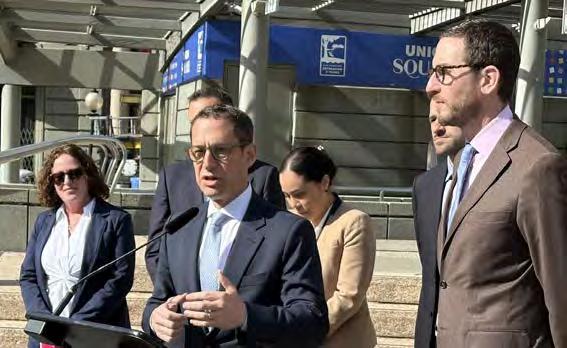
south with Second and Fifth streets as the boundaries south of Market Street, and Kearny Street on the east, Bush Street on the north, and Mason and Taylor streets on the west north of Market.
That places the hospitality zone one block at its closest point to the Leather and LGBTQ Cultural District, which showcases several queer bars and nightclubs in the South of Market area. LGBTQ bar Ginger’s in the Financial District borders the hospitality zone, as it is just east of Kearny Street. The proposed zone is also adjacent to the boundaries of the Transgender District.
Once a county’s allotment of liquor licenses is exhausted, as San Francisco’s has been for eight decades, according to a news release from the mayor’s office, the only way to acquire one is on a secondary market, where they can go for hundreds of thousands of dollars. Wiener’s bill would allow new bars to open if located within the boundaries of the hospitality zone.
The Department of Alcoholic Beverage Control would be authorized to issue up to 20 new, on-sale liquor licenses within the district if the bill is passed by the legislature and signed by Governor Gavin Newsom, himself a former San Francisco mayor. The license fee would only be $20,000. The department stated to the B.A.R. Feb-
ruary 18 that it “does not comment on pending legislation.”
A Wiener spokesperson stated that they haven’t engaged with the ABC yet, but will do so “later in the legislative process.”
“Our office sees a strong pathway forward for this legislation,” the spokesperson stated.
Entertainment Commission President Ben Bleiman, founder of the SF Bar Owners Alliance, said during the news conference that prohibitive costs of liquor licenses have stymied bar owners who might have wanted to open up downtown.
“A lot of our best nightlife, a lot of our best restaurants and hospitality and clubs, they actually don’t start downtown or [in] SOMA,” Bleiman said. “They start in the outer neighborhoods all over the city, but a lot of those operators have felt priced out from downtown. It’s really hard for them to get a foothold here, and I expect that many people who kind of thrive in other areas of the city will take a look at this and say now is my chance to move down here.”
An owner of several San Francisco bars, Bleiman said, “If downtown is the circulatory system, Union Square is the heart. As Union Square goes, the entire system kind of is dependent on it.”
Improvements seen
Bleiman spoke to the need to reinvigorate the downtown area, which has not fully recovered from the COVID pandemic lockdowns. The streets, bereft of office workers, many of whom are still working from home, highlighted openair drug use and sales in the eyes of the public and the media. Combined with issues concerning car break-ins, and organized retail theft, businesses began an exodus. According to a report from the Institute of Governmental Studies released in 2023, downtown San Francisco ranked last among 62 North American cities in recovering from the pandemic. A more recent report from the institute found San Francisco was No. 11 in its improvement on the number of visits from May 2023 to May 2024 after that number rose by 15%.
The city Controller’s office reported last month that for the first time since 2020 the office vacancy rate dropped, albeit “slightly.” The job market grew 1.4% from October to December 2024 and regular visits by employees rose – but the formation of new businesses and “occasional visits” trended downward.
Just before Ginger’s re-opened last year, the LGBTQ nightclub Club OMG in the Sixth Street corridor shuttered.
“It brings a ton of economic activity – tax dollars that get spread around the city – and also a vibe,” Bleiman said of downtown. “It’s energy, it brings people, it brings all sorts of intangible things. … Nightlife, entertainment, performance, art are not going to be a crucial part of re-envisioning downtown. They’re actually going to be the main driving force because without them people are simply not going to want to visit downtown.”
Lurie is continuing the efforts of his predecessor to change the perception of downtown San Francisco. Numerous speakers at the news conference touted the holiday weekend confluence of the Lunar New Year parade and the NBA All-Star game as a massive success –and indeed NBA Commissioner Adam Silver stated on the mayor’s very active social media over the weekend that the city is experiencing a “renaissance” and a “sense of optimism.”
“I’ve sensed more energy these last several days here than I’ve experienced in a long time,” Silver stated. Wiener quipped the weekend was such a whirlwind that, “I was exhausted looking at his [Lurie’s] social media, between the All-Star game and, from my perception, the largest crowd for the Chinese New Year parade I’ve ever seen.”
“San Francisco is back and is getting stronger and stronger by the day,” Wiener said. “We need to continue to build on the progress we have made and we know that downtown, the Financial District, Union Square, South of Market, Yerba Buena, is absolutely essential for San Francisco’s recovery, for our economic vitality.”
Lurie said that he hopes legislation like SB 395 will make busy, fun times for visitors and residents alike more common.
“Every time I visited the streets were packed and teeming with people,” he said. “To get our economy going again, all of downtown needs to be at full strength, and this weekend was a great way to get people here. Now, today, we are taking the next step with permanent solutions for this neighborhood.”
District 3 Supervisor Danny Sauter, who represents Union Square, said that he’s “really proud to support this effort.”
“I see it as the next piece of the puzzle to bring Union Square back,” he said. “On my way over here today, I saw many of those pieces in action. We have ambassadors who are working to keep this neighborhood friendly and safe, we have our SFPD here with a concentration in the new hospitality zone. I was told about 200 days of programming now in Union Square, bringing people back into this square, giving people more reasons to come here.”
District 6 Supervisor Matt Dorsey represents the south side of the hospitality zone by Moscone Center. He was not at the news conference and declined to comment when contacted by the B.A.R. February 18. t
by John Ferrannini
Rates of all bacterial sexually transmitted infections in San Francisco were down by the end of 2024 compared to the previous year, according to the year-end STI report released by the health department on Valentine’s Day.
A subject matter expert was not immediately available for comment February 14, but doctors have told the Bay Area Reporter in the past they think adoption of doxyPEP is making a positive impact.
DoxyPEP – a novel way of treating bacterial sexually transmitted infections with the antibiotic doxycycline (a type of tetracycline) after unprotected sex – has been approved for men who have sex with men and for trans women.
The report shows the total number of gonorrhea cases down from 4,988 at the end of 2023 to 4,799 at the end of 2024, though male rectal gonorrhea cases only are up from 1,585 to 1,696. This tracks with the doxyPEP hypothesis, though, as doxycycline has limited impact on gonorrhea.
“Gonorrhea has a real potential to develop [antibiotic] resistance, although doxycycline is not something we use for gonorrhea anymore because the cat is out of the bag there,”
by Liz Highleyman
T
wice-yearly lenacapavir PrEP
could be available as early as this summer pending federal Food and Drug Administration approval, with a decision expected in mid-June, Gilead Sciences Inc. announced Tuesday. Preparations for the U.S. launch are “well underway,” according to Gilead chief commercial officer Johanna Mercier.
“Today, we are one step closer to introducing the first-ever twiceyearly HIV prevention choice that could, if approved, help transform the landscape for individuals who need or want additional prevention options that better fit into their lives,” Gilead Chief Medical Officer Dr. Dietmar Berger stated in a news release.
“We’re excited about the potential of lenacapavir to make a real difference in HIV prevention in the U.S. and around the world, supporting the broader goal of ending the HIV epidemic for everyone, everywhere.”
Lenacapavir is an HIV capsid inhibitor with a long half-life in the body, meaning it can be administered once every six months. Phase 3 studies showed that it dramatically reduced HIV acquisition in groups at high risk. Lenacapavir is an antiretroviral drug that blocks HIV replication. It’s not a vaccine that trains the immune system to fight the virus. All traditional vaccine candidates tested so far have failed, so long-acting PrEP is the next best thing. Currently, ViiV Healthcare’s Apretude (injectable cabotegravir), which is administered every other month, is the longest-acting approved PrEP option.
As the Bay Area Reporter previously reported, the PURPOSE 1 trial, first presented at the 2024 International AIDS Conference, showed that lenacapavir injections every six months were 100% effective for young cisgender women in Africa.
See page 9 >>

Dr. Matt Spinelli, a UCSF assistant professor and medical lead of the PrEP clinic at Ward 86 told the B.A.R. for a report last year.
Looking at chlamydia, there were 4,214 reported cases at the end of 2024 in San Francisco compared with 5,622 at the end of 2023. Looking at male rectal cases only, 2024 had 827 cases compared with 1,434 at the end of 2023.
Total syphilis cases were down to 888 at the end of 2024 compared with 1,156 at the end of 2023. Cases of syph-
ilis in cisgender women were down from 174 at the end of 2023 to 154 at the end of last year. Syphilis in women is a health priority as officials seek to prevent cases of congenital syphilis, of which there were only three cases in 2024 compared with six in 2023.
The report directly ties the declines to doxyPEP, citing a January 6 Journal of the American Medical Association study that linked declines in syphilis and chlamydia to the introduction of doxyPEP in San Francisco.


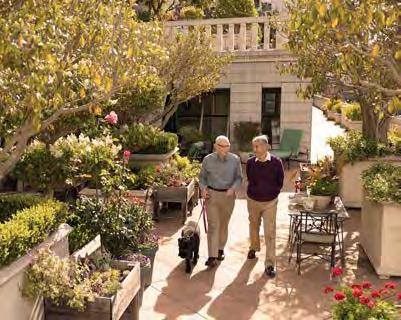
“However, despite the citywide decline in STIs, disparities persist,” the report stated.
“There was a 11.5% decrease in syphilis cases among cis women from 2023 to 2024, less than half the decrease compared to men (the majority of whom were reported as gay, bisexual, or having had sex with other men),” the report stated. “People experiencing homelessness and people who use drugs also continue to be disproportionately affected by syphilis and congenital syphilis (CS). Encouraging in 2024 is that SF had 3 cases of congenital syphilis (CS), half as many cases as the year prior. Over the past year the Congenital Syphilis Taskforce developed a strategic plan identifying strategies the San Francisco Department of Public Health will employ over the next three years to move toward elimination of CS in SF.”
The report found racial disparities, too.
“The 2024 STI data also show that Black/African Americans (B/AA) continue to be disproportionately affected by CT [chlamydia], GC [gonorrhea], and early syphilis,” the report stated. “These racial disparities are even more notable when comparing B/AAs <20 years old compared to whites <20 years old. The B/AA Health Initiative (BAAHI) STI Work
Group continues to convene monthly and is planning sexual health interventions to improve equity for B/AA youth and young adults.”
There was one acute case of HIV (which is a virus, and not covered by doxyPEP protection) infection reported at City Clinic at the end of 2024, compared with three at the end of 2023. The total number of new HIV cases in 2023 in the city fell to 133 from 157 in 2022, under the leadership of AIDS expert Dr. Grant Colfax at the health department.
As the B.A.R. reported earlier this week, Mayor Daniel Lurie chose former Biden U.S. Centers for Medicare and Medicaid Services head Daniel Tsai as his new pick to lead the health department. Tsai is the first director of health who isn’t gay or lesbian in over three decades.
City Clinic will be moving to an upgraded facility with the passage of Proposition B last November. As the B.A.R. reported last year, the current 91-year-old former firehouse on Sixth Street, in which the public health facility is currently located, is in a state of disrepair. Seventy-five percent of those served by the clinic are men who have sex with men and they rely on the sexual health services it provides. t
At San Francisco Towers, we believe home is more than just a place—it’s a feeling. Our beautifully appointed apartments offer both the comfort of personal space and the richness of connection. This is where refined living meets authentic community, where each day brings opportunities for meaningful experiences and true belonging.
The decision is yours, and the possibilities are endless.
by John Ferrannini
The Castro LGBTQ Cultural District is looking ahead now that a key report has been approved by the San Francisco Board of Supervisors. At its February 4 meeting, the full board OK’ed the document that focuses on the cultural district’s vision for the LGBTQ neighborhood.
The report also details how the district’s vision should continue to be implemented.
As the Bay Area Reporter previously reported, the CHHESS Report (Cultural History, Housing, and Economic Sustainability Strategies) had been forwarded to the full board by the Board of Supervisors Land Use and Transportation Committee on January 27. It was passed without objection by the full board and does not need a second vote.
The 133-page report, required of the city’s cultural districts, was finished in 2024 after years of work. It contains some 30 recommendations listed under six policy areas.
Gay Board of Supervisors President Rafael Mandelman, who represents District 8 (including the Castro neighborhood), stated to the B.A.R. February 6 that the adoption of the report is “an important milestone for the district, and I look forward to continuing our partnership to support queer arts and culture in

Strategies) that was approved by the Board of Supervisors at its February 4 meeting.
the Castro.” Castro LGBTQ Cultural District Director Tina Aguirre, a genderqueer Latinx person, told the B.A.R. February 5 that the staff is thankful for the supervisors’ approval and that they are looking forward to the work ahead.
“The staff and advisory board members of the Castro LGBTQ Cultural District appreciate the vote of approval
by members of the Board of Supervisors,” Aguirre stated. “We look forward to working with the city, community partners, and community leaders to implement key strategies identified in the plan. Together, we will ensure that queer and trans people are centered in the Castro and San Francisco.”
Aguirre told the B.A.R. that now that the report has been approved, they will
be seeking to implement the recommendations it contains under six different policy areas: gentrification, tenant protections, placekeeping and placemaking, cultural humility and competence, arts and culture, and heritage recognition and preservation.
For example, the district is working on creating a booklet, “Castro LGBTQ Cultural Heritage,” to highlight the neighborhood’s history.
“The publication documents the emergence and development of the Castro as a queer mecca,” Aguirre stated.
The district highlighted lesbians as part of its Living Lesbian Legends Project. Now, the district is “commissioning new art to focus on trans masc and transgender men,” Aguirre stated. That’s expected to start in the spring.
The artwork of Tanya Wischerath, who painted the lesbian portraits, will be used for a mural in the parking lot behind the Walgreens at 498 Castro Street.
Aguirre stated that the district will continue to co-produce the annual Harvey Milk Day celebrations in May and the memorial to the victims of the Pulse nightclub massacre in June. Now, the district is supporting the Dyke March as it begins anew.
As the B.A.R. previously reported, the annual event bringing lesbian visibility to the Castro and Mission neigh-
borhoods didn’t officially take place last June. It was traditionally held the Saturday before the city’s LGBTQ Pride parade.
As a result, an interim steering committee was formed to organize and plan a Dyke March for 2025, and at least three town halls have been held over the last few months.
“We are also supporting the Dyke town halls regarding the resurgence of the Dyke March rally,” Aguirre stated.
M Rocket, the Dyke March’s interim project director, stated to the B.A.R. February 5 that the district has been helpful.
“Tina Aguirre and the Castro LGBTQ Cultural District has been integral in the efforts to relaunch the SF Dyke March and the community’s rebuilding of the organization and events for 2025,” Rocket stated. “So far, the district has helped by sharing resources, and they sponsored our Dyke Town Hall #2 held at the SF LGBTQ center last November.”
The cultural district is planning a town hall of its own on housing.
“We are also learning about how to work with development corporations in case a small site acquisition is needed in the neighborhood to preserve rent control units. We hope to have a town hall to present information that we find,” Aguirre stated. t
by John Ferrannini
Residents in San Francisco’s Castro district are reacting to the death this week of a beloved unhoused man who spent many years on the streets in the LGBTQ neighborhood. A memorial took place February 17.
Dale Coverdell was found dead February 11 on the 500 block of Castro Street, between 18th and 19th streets. His age was not immediately available.
The Castro Community Benefit District stated on Instagram that Mr. Coverdell had lived on the streets of the Castro for a long time. It organized a memorial that took place at the Hibernia Beach area outside the Bank of America building at Castro and 18th streets, where so many have been mourned over the years.
“He died alone on a cold rainy morning,” the post stated. “There has to be a better way!”
Gay Castro resident Christopher

Vasquez remembered Mr. Coverdell as “an absolute fixture in the neighborhood.”
“My dog Ziggy and I would see him nearly every day,” he stated. “He was always so kind, so caring, and
would regularly take the time to call out Ziggy as a basenji. One time he told us a story about how he grew up with basenjis, among other great stories about his life. I know other friends with dogs that he was also constantly
very friendly with. His loss is also very tragic – and sadly also just another reminder that our city, state, and federal governments are not doing nearly enough to prioritize the health, safety, and wellbeing of our most vulnerable living on the streets.”
A San Francisco Police Department spokesperson stated to the Bay Area Reporter that at 10:36 a.m. February 11, “Officers arrived on scene and met with paramedics who were already at the scene. Paramedics declared the adult male deceased. The medical examiner responded to conduct their investigation. At this time, there is no evidence of foul play at this stage of the investigation.”
The Office of the Chief Medical Examiner didn’t return a request for comment by press time.
Bill Pung, the co-owner of Orphan Andy’s, told the B.A.R. that Mr. Coverdell “looked pretty healthy every time I saw him.”
“I’m sorry he had passed,” Pung
said. “The elements are just horrible out when it’s raining and it’s freezing cold out there.”
Pung remembered Mr. Coverdell as “a nice guy.”
“Every time I’d see him going down Castro Street, he’d be sitting, greeting people, always in a good mood, and just interacting with people walking by,” Pung said. “I’d see him sitting there, reading a book, and if I have something I’d give it to him, help him out. He was never aggressive.”
Gay Board of Supervisors President Rafael Mandelman, who as District 8 supervisor represents the Castro at City Hall, shared a similar sentiment about Mr. Coverdell as others in the neighborhood.
“It’s very sad,” he stated to the B.A.R. “We’re leaving far too many sick people to die on our sidewalks, and it’s wrong.”
Anyone with information on the case is asked to contact the SFPD at 415-575-4444. t
by John Ferrannini
The San Francisco County Transportation Authority has approved the allocation of funds for a study of traffic patterns in the city’s Castro LGBTQ district that may have wide-reaching impacts for vehicles using Market Street trying to access Duboce Triangle and westside neighborhoods in the city.
The authority – which is composed of the 11 members of the Board of Supervisors – voted February 11 to approve $250,000 for the Duboce Triangle Slow Streets Study.
“I want to thank the Transportation Authority staff and the MTA staff for all the work in particular on the Duboce Triangle study,” said gay Board of Supervisors President Rafael Mandelman, who represents the Castro and Duboce Triangle neighborhoods, referring to the Municipal Transportation Agency. “I’m looking forward to it. It’s going to be an opportunity to think through the Triangle in a holistic sense instead of project by project. It is needed. Thank you for being able to put that on.”
The study, being paid for with Propo-

sition L funds, will examine opportunities for north-south bike connections through the neighborhood but, perhaps most importantly, will also assess traffic patterns so as to help determine if Sanchez and Steiner streets should be converted to slow streets and explore corresponding changes to traffic, which could include closing northbound Noe and
Sanchez streets to left-hand turns from Market Street, where they are currently allowed, and opening northbound Castro Street to those turns, where they are currently not allowed.
Currently, vehicles headed eastbound on Market Street toward downtown are prohibited from turning left at Castro Street. They can turn left at the next block, Noe Street, or at Sanchez Street, where there are dedicated left-hand turn lanes for vehicles.
The traffic pattern has long raised complaints from Duboce Triangle residents, as it funnels all eastbound Market Street traffic headed to the Haight, Alamo Square, and other neighborhoods on the city’s westside through their leafy, historic neighborhood nestled between the Castro and the Lower Haight. During the COVID pandemic, they worked with city transit officials to designate a part of Noe Street as a Slow Street, meaning it should not be used as a thruway by vehicles passing through Duboce Triangle.
Some in the neighborhood want to see such pass-through traffic be rerouted onto Castro Street by allowing left-hand
turns onto northbound Castro Street at Market Street.
The transportation authority included community outreach in the item, and a final report will be issued in spring 2026.
As the Bay Area Reporter previously reported, any changes would require tweaks to the Market and Castro intersection. As currently configured, there are two lanes for vehicles headed eastbound. There is also a third lane dedicated for Muni buses and vehicles making a right-hand turn onto Castro Street.
For cars coming in the other direction, there are dedicated lanes for vehicles turning right or left onto Castro Street, with the traffic signal timed to allow left hand turns. In the middle are two lanes for westbound traffic headed to Twin Peaks and Forest Hill, with the rightmost lane allowing vehicles once they cross the intersection to turn into the Castro Gas and Food Mart or veer right onto 17th Street headed up to Corona Heights.
A wide pedestrian crosswalk runs across Market Street from the entrance into the gas station on the northbound side of Castro Street to Harvey Milk
Plaza on the southbound side. As part of a new elevator being built at the public parklet above the Castro Muni Station, the sidewalk adjacent to Market Street is to be expanded into the roadway to provide better pedestrian access from Castro Street to the elevator stop onto Market Street. It is targeted to open by early 2026.
When told about the February 11 vote, Duboce Triangle Neighborhood Association President Jon Moscone, a gay man who is the son of the late mayor George Moscone, said, “That’s great.”
“I think my one comment is I am very much looking forward to the robust community engagement process they promised us, and that is now in the budget, and for finding a holistic solution to the traffic situation for our neighborhood,” he continued.
Moscone had told the B.A.R. that the request for the study initially came out of Duboce Triangle residents’ complaints about a lack of community engagement from the San Francisco Municipal Transportation Agency about the future of the Slow Street in their neighborhood. t
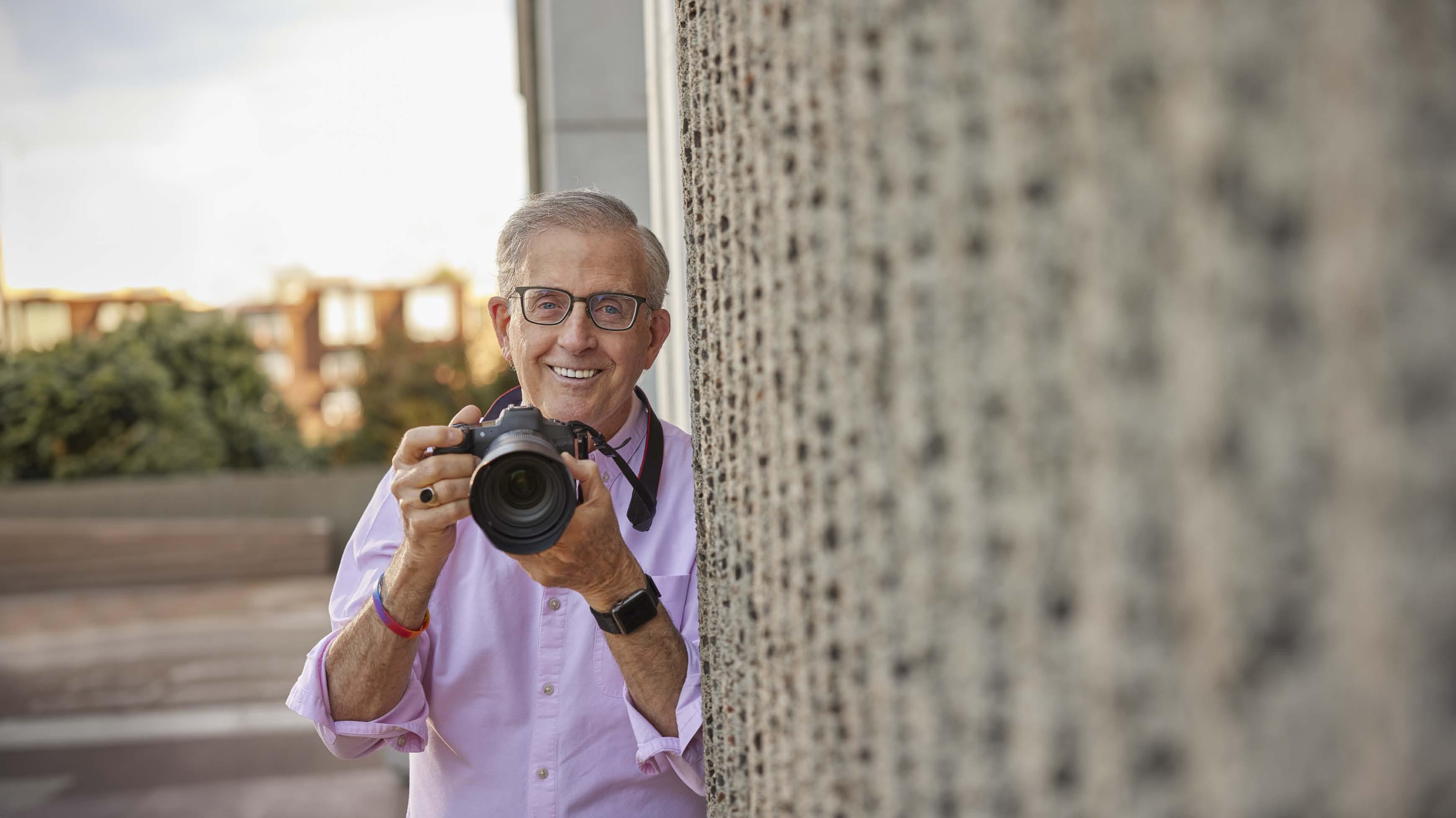


Volume 55, Number 8
February 20-26, 2025 www.ebar.com
IPUBLISHER
Michael M. Yamashita
Thomas E. Horn, Publisher Emeritus (2013)
Publisher (2003 – 2013)
Bob Ross, Founder (1971 – 2003)
NEWS EDITOR
Cynthia Laird
ARTS & NIGHTLIFE EDITOR
Jim Provenzano
ASSISTANT EDITORS
Matthew S. Bajko • John Ferrannini
CONTRIBUTING WRITERS
Christopher J. Beale • Robert Brokl
Brian Bromberger • Victoria A. Brownworth
Philip Campbell • Heather Cassell
Michael Flanagan •Jim Gladstone
Liz Highleyman • Brandon Judell • Lisa Keen
Philip Mayard • Laura Moreno
David-Elijah Nahmod • Mark William Norby
J.L. Odom • Paul Parish Tim Pfaff
Jim Piechota • Adam Sandel
Jason Serinus • Gregg Shapiro
Gwendolyn Smith • Charlie Wagner
Ed Walsh • Cornelius Washington • Sura Wood
ART DIRECTION
Max Leger
PRODUCTION/DESIGN
Ernesto Sopprani
PHOTOGRAPHERS
Jane Philomen Cleland
Rick Gerharter • Gooch
Jose A. Guzman-Colon • Rudy K. Lawidjaja
Georg Lester • Rich Stadtmiller
Christopher Robledo • Fred Rowe
Shot in the City • Steven Underhill • Bill Wilson
ILLUSTRATORS & CARTOONISTS
Christine Smith
VICE PRESIDENT OF ADVERTISING
Scott Wazlowski – 415.829.8937
NATIONAL ADVERTISING REPRESENTATIVE
Rivendell Media – 212.242.6863
LEGAL COUNSEL
Paul H. Melbostad, Esq.


Bay area reporter
44 Gough Street, Suite 302 San Francisco, CA 94103
415.861.5019 • www.ebar.com
A division of BAR Media, Inc. © 2025
President: Michael M. Yamashita
Director: Scott Wazlowski
News Editor • news@ebar.com
Arts Editor • arts@ebar.com
Out & About listings • jim@ebar.com
Advertising • scott@ebar.com Letters • letters@ebar.com
Published weekly. Bay Area Reporter reserves the right to edit or reject any advertisement which the publisher believes is in poor taste or which advertises illegal items which might result in legal action against Bay Area Reporter. Ads will not be rejected solely on the basis of politics, philosophy, religion,
t is appalling and wrong that the federal government on February 13 deleted references to “transgender” and “queer” from the web pages of the Stonewall National Monument. The original material must be restored. The site, and the monument in Greenwich Village New York, is part of the National Park Service, which is overseen by the U.S. Department of the Interior. The monument, of course, honors the 1969 Stonewall riots when transgender, bisexual, gay, and lesbian patrons of the Stonewall Inn pushed back against targeted harassment and police raids. It’s considered the birth of the modern LGBTQ rights movement. The removal of “transgender” and “queer” is just another example of President Donald Trump’s obsession with eliminating all references to trans people – as if that will make them disappear from society.
And it’s not just Stonewall. At the Rosie the Riveter WWII Home Front Museum in Richmond, California, there was confusion last month after an LGBTQ history-related exhibit was removed and then returned. And it seems that the anti-trans purge has come to the museum’s website. While the words “transgender” and “queer” and the LGBTQ acronym were on the site February 13, those had been replaced with “LGB” by February 18.
That content must also be restored.
The Stonewall National Monument was designated as such by former President Barack Obama in 2016. “I’m designating the Stonewall National Monument as the newest addition to America’s National Park System,” Obama said at the time. “Stonewall will be our first national monument to tell the story of the struggle for LGBT rights. I believe our national parks should reflect the full story of our country, the richness and diversity and uniquely American spirit that has always defined us. That we are stronger together. That out of many, we are one.”
In 1999, the Stonewall Inn was listed on the National Register of Historic Places and the area was declared a National Historic Landmark in 2000.

The website of the
National Monument has been purged of LGBTQ and replaced with LGB.
Yet Trump and his administration are obsessed with making transgender content disappear from government sites, and that will have dangerous consequences. Revising history, as the park service has done with the Stonewall National Monument and Rosie the Riveter sites, doesn’t mean that the events didn’t occur, or that trans people weren’t involved. It means that the federal government is working overtime to wrongly change the accuracy of the events. And while there are books, archived interviews online, and news coverage showing the role trans people played in Stonewall, many people may not check out those resources. That’s why the website information that the National Park Service maintains is so important. And why the removal of trans participation in events like Stonewall and World War II distort history.
Unchallenged erasure risks becoming normalized, threatening hard-won progress, as the Human Rights Campaign noted in an alert in which it encourages people to sign a petition directed to Interior Secretary Doug Burgum, the Republican former governor of North Dakota
and a 2024 presidential candidate. It’s Burgum’s department that oversees the park service.
Other actions
As we’ve noted, other actions Trump himself has taken pose potentially harmful outcomes, such as his executive order banning the use of gender-affirming hormone therapies for transgender adolescents. That has already had a chilling effect as several hospitals have now paused such treatments, including Children’s Hospital Los Angeles. As we’ve reported, another order targets affirmative actions that schools across the U.S. have taken to support queer and transgender students, from teaching LGBTQ curriculum and providing gender-neutral bathrooms to honoring students’ preferred pronouns and names and allowing them to play on athletic teams regardless of the sex they were assigned at birth. Another bans trans women and girls from playing on female sports teams. Trump’s executive order banning trans people from serving in the military went into effect February 7 with the announcement that trans people can no longer enlist.

Just last weekend, CBS News reported that the Equal Employment Opportunity Commission is seeking to drop six of its own cases on behalf of workers alleging gender discrimination. That is to comply with Trump’s executive order stating there are only two genders, male and female, and that a person’s gender is determined at conception. The decision is contrary to the EEOC’s updated guidance from last year specifying that deliberately using the wrong pronoun for someone, or refusing them access to a bathroom that corresponds to their gender identity, constitutes harassment. That followed the landmark 2020 U.S. Supreme Court decision that gay, lesbian, and transgender people are protected from employment discrimination.
by Gwendolyn Ann Smith
In the first weeks of Donald Trump’s second presidency, the administration hurriedly issued executive orders that attempt to strip transgender people of what scant rights we already have, all while seeking to erase us at all levels. The only thing that has stopped the wholesale trampling of trans lives has been a handful of judges ruling that laws still matter.
By the time you read this, we may see if judges still hold any sway at all.
These actions by Trump – as well as transgender people asking for our rights to be protected, if I may be so frank – have been labeled as “distractions.” As the orders themselves are of dubious enforcement, it is argued, we should instead focus on some of the other illegal actions of this nascent dictatorial presidency.
My personal feelings are simple: nothing Trump or his administration does is a distraction. Every one of these is perfectly legitimate. Yes, even the threats about the U.S. buying Greenland.
More than this, myself, and all other transgender and nonbinary people, are not distractions, but human beings. When people in the administration act on these executive orders, they are caus ing direct harm to actual, factual, living people – not abstract distractions. If you cannot see that, then that’s on you and your own biases.

and some six years before World War II. Trans people ended up in concentration camps, along with other members of our LGBTQ community.
Niemöller was also sent to a camp in 1937.

Advertising rates available upon request. Our list of subscribers and advertisers is confidential and is not sold. The sexual orientation of advertisers, photographers, and writers published herein is neither inferred nor implied. We are not responsible for unsolicited manuscripts or artwork.
People often cite Pastor Martin Niemöller’s “First They Came” poem in these times, about how the Nazis came for socialists, and trade unionists, and Jews, before they came for him. Yet, while Niemöller was writing about his own experiences, learning that his own antisemitism did not provide him cover for the atrocities of the Nazi regime, it is also a poem that forgets that one of the first groups the Nazis came for were LGBTQ people –and more specifically, transgender people.
The Institut für Sexualwissenschaft (Institute of Sexual Research) was one of the largest repositories of information on LGBTQs in prewar Germany, and was a source of employment for many transgender people at the time. It was destroyed in May 1933, two years before the Nuremberg Laws stripped German Jews of their citizenship,
Yet, when liberation came to the camps in 1945, the freedom that Niemöller and many others felt did not mean freedom for the gay and trans people held there. As others were freed, they were sent to other prisons, and had to serve out their sentences regardless of the time they spent in the camps. It wasn’t until 1994 that Paragraph 175, the law used to hold them, was abolished, and it wasn’t until 2002 that those convicted were pardoned, according to the National Holocaust Museum in the United Kingdom. Even now, the involvement of those we’d call transgender today is largely glossed over, or forgotten outright. Former children’s author and full-time anti-trans bigot, JK Rowling, has publicly denied that transgender people suffered through the Holocaust.
As far as I could find, Niemöller did not speak on LGBTQ people, let alone anything specific to trans people. I would not be surprised if he was firmly opposed to our existence. Certainly, he saw no reason to mention us in his poem.
As much as Niemöller gets quoted, it’s worth remembering that he was wrong. He only acted in hindsight, once he was under threat. To him, I presume, all the others were just distractions, just like trans people are seen today.
Let’s jump forward, to a June day in 1969, and a New York City bar called the Stonewall Inn. I suspect we all know what happened when police
raided that bar, helping to form the flashpoint that led to the modern LGBTQ movement.
We know there were a lot of people and a lot of different identities in the mix, but chief among them were some very brave people who we, once again, would consider trans in our modern parlance.
You won’t find this on the official website for the Stonewall National Monument, which last week clumsily removed “transgender” from the language on the site, truncating LGBTQ+ to LGBQ+, then later simply LGB. A page about Sylvia Rivera, a trans woman who has become a pivotal part of the Stonewall story, has seen her own page awkwardly edited to say, “Sylvia Rivera began fighting for gay and rights.” You can easily guess what’s missing.
I presume that our existence is simply too distracting, and we need to be scrubbed from even the history that directly includes us, even as our distracting real lives are under threat.
Finally, let me speak once more about the months since the election. The body of Sam Nordquist, a 24-year-old transgender man, was found in a field in upstate New York on February 13. For more than a month, Nordquist had been beaten and sexually assaulted by five people. While not a lot of specifics have come out about the case, Ontario County District Attorney Jim Ritts has said to local reporters that this murder is, “by far the worst homicide investigation that our office has ever been a part of.”
This week, it was reported that authorities don’t have evidence of a hate crime in Nordquist’s death and said that some, or all, of the suspects are themselves members of the LGBTQ community.
You will not hear about this killing from our federal government, any more than you will hear about much else regarding transgender people.
I feel that once Trump’s crimes are listed in the history books, trans people will be omitted, our names scrubbed away as easily as they are from the Stonewall website, and as mercilessly as those who were kept imprisoned in Germany.
As for me, I feel that we need to be as distracting as possible. It’s our lives that are literally on the line. t
Gwen Smith may not sting like a bee, but she does annoy like a gnat. You’ll find her at the newly-revised gwensmith.com
by Matthew S. Bajko
Alocal paving contractor this month is expected to reinstall a granite plaque for a San Francisco historic transgender site that was damaged during a streetscape project in the city’s Tenderloin district. It comes weeks after the location was listed on the National Register of Historic Places, making it the first known property to receive such federal recognition due to its importance to the trans community.
The commemorative sidewalk plaque had been installed in front of 101 Taylor Street where one night in August 1966 a drag queen patron of Gene Compton’s Cafeteria got into an altercation with a police officer that resulted in a riot by LGBTQ customers of the all-night eatery. While the exact date of the incident has been lost to history, it received greater recognition as a seminal moment in LGBTQ history due to the 2005 documentary “Screaming Queens” by transgender scholar and historian Susan Stryker, Ph.D.
The damaged sidewalk marker had been unveiled during Pride Month in 2006 as part of the commemorations for the 40th anniversary of what has become known as the Compton’s Cafeteria riots. As the Bay Area Reporter noted at the time, the plaque partly read, “transgender women and gay men stood up for their rights and fought against police brutality, poverty, oppression and discrimination in the Tenderloin. We, the transgender, gay, lesbian, and bisexual community, are dedicating this plaque to the heroes of our civil rights movement.”
It was damaged in the course of work on the Safer Taylor Street Project that saw the roadway be redesigned to slow down vehicles and provide a safer environment for pedestrians. The $9 million-plus project began in January 2022 and its completion was officially celebrated by city transit officials and elected leaders last month on January 3.
In response to questions from the B.A.R., San Francisco Public Works spokesperson Rachel Gordon explained that, “Contractor crews accidentally damaged the plaque when it was removed for sidewalk work as part of the Safer Taylor project. A replacement plaque has been fabricated, and our project landscape architect will give it a final review before installation to make sure it matches the quality and look of the old plaque.”
Gordon did not disclose how much the new plaque is costing but did say the project’s contractor is “covering the replacement costs.” She added that it is expected to install it sometime next week, as early as Monday, February 24.
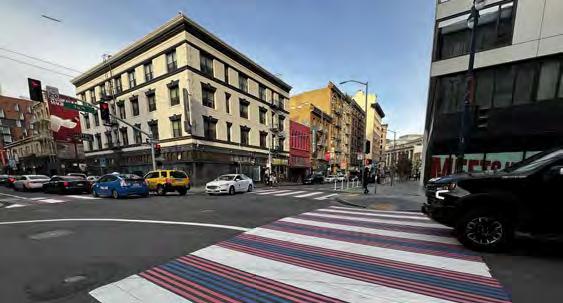

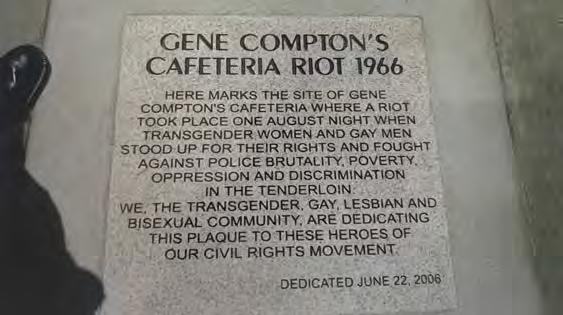
A second bronze plaque honoring the history of the former Compton’s location was not damaged during the street construction work and can be found on Turk Street right at the corner of Turk and Taylor streets. It is embedded in the sidewalk right behind the traffic light pole and in front of a pair of planter boxes, currently devoid of plants.
The historic marker, funded in 2011 via San Francisco’s Neighborhood Arts Collaborative, was one of nine installed at historic sites within the Uptown Tenderloin National Historic District, as the local blog Beyond Chron noted at the time.
Their installation was part of the district’s “Lost Landmarks” initiative.

The Compton’s plaque partly reads, “This confrontation was the first known full-scale riot for transgender and gay rights in U.S. history. It galvanized the community, prompting new public policies and social services that improved the lives of local transgender people.”
“We know how important these plaques are in telling and showcasing this important community history,” noted Gordon, who became part of local LGBTQ history when her former employer, the San Francisco Chronicle, forbade her from covering same-sex marriage stories due to her 2004 marriage to her wife, at the time a photographer for the daily newspaper, which generated national headlines and an outcry from local LGBTQ leaders.
Locally-based Esquivel Grading and Paving Inc., was the lead contractor for the Taylor Street redesign. Reached by phone February 18, a representative for Esquivel told the B.A.R. she wasn’t sure if the company could comment but said to submit any questions by email.
The company, in turn, forwarded to public works staff the B.A.R.’s questions on what it is costing to replace the historic marker and if it had a firm date for when it will be installed. The city department had yet to provide answers by the B.A.R.’s press deadline Wednesday.
The streetscape project for Taylor Street also resulted in the installation of decorative crosswalks and seating cubes highlighting the Transgender District, as noted in a 2023 contract update document. The cultural area recognizes the neighborhood’s importance to the transgender residents who have long called it home, as well as its place in the development of the city’s broader LGBTQ community.
As such, crosswalks sporting the blue, white, and pink colors of the Transgender Pride flag can be found on all four sides of the Turk and Taylor intersection. Just up the street at 132 Turk Street is queer sex club Eros, while directly across the roadway at 133 Turk is Aunt Charlie’s, the Tenderloin’s last remaining queer bar known for its drag shows.
As for the building that once housed Compton’s, the private company GEO Group owns the property and operates a residential reentry facility there for people recently released from prison. Known as the 111 Taylor St. Apartments, its residents stay anywhere from six months to a year, according to the program’s website. There is talk of having the city landmark the entire building, which would provide it a modicum of
protection, as any proposals for the site would trigger greater scrutiny of the plans by city planning staff. In 2022, San Francisco officials landmarked the intersection of Turk and Taylor in front of the building in recognition of the uprising by the LGBTQ Compton’s patrons.
The city’s 307th landmark also included portions of the structure’s exterior walls containing the commercial space that had housed the Compton’s eatery, specifically the lower 11 feet of the facade extending north 52 feet from the corner of Turk Street and 40 feet west from the corner of Taylor Street.
As the B.A.R. was first to report, the keeper of the register for federallyrecognized historic properties listed the Compton’s site on January 27 without any fanfare. The news of the national recognition reached local advocates earlier this month.
“Today, the Compton’s Cafeteria riot is remembered as a turning point towards militant resistance in the LGBTQ, and particularly transgender, community throughout the United States,” according to the application for its listing, which also noted that it has national significance “because of its influence on the future political and social representation of transgender and gendervariant people within the United States.”
The events that took place at Compton’s “support a multi-nodal view of the gay rights movement throughout the country; each event building and learning off each other,” per the document.
This spring the Tenderloin Museum is mounting a revival of the interactive theater piece “Compton’s Cafeteria Riot” that it had premiered in 2018. It opens April 11 and tickets are already on sale via the website https://www.comptonscafeteriariot.com/
The play and replaced plaque for Compton’s come as the Trump administration attempts to erase the transgender community from public view. As was widely reported last week, the National Park Service removed the term “transgender” then also “queer” from the website for the Stonewall National Monument that recognizes the LGBTQ uprising against police harassment of queer and trans patrons of the Stonewall Inn bar in 1969, three years after the Compton’s riot. t



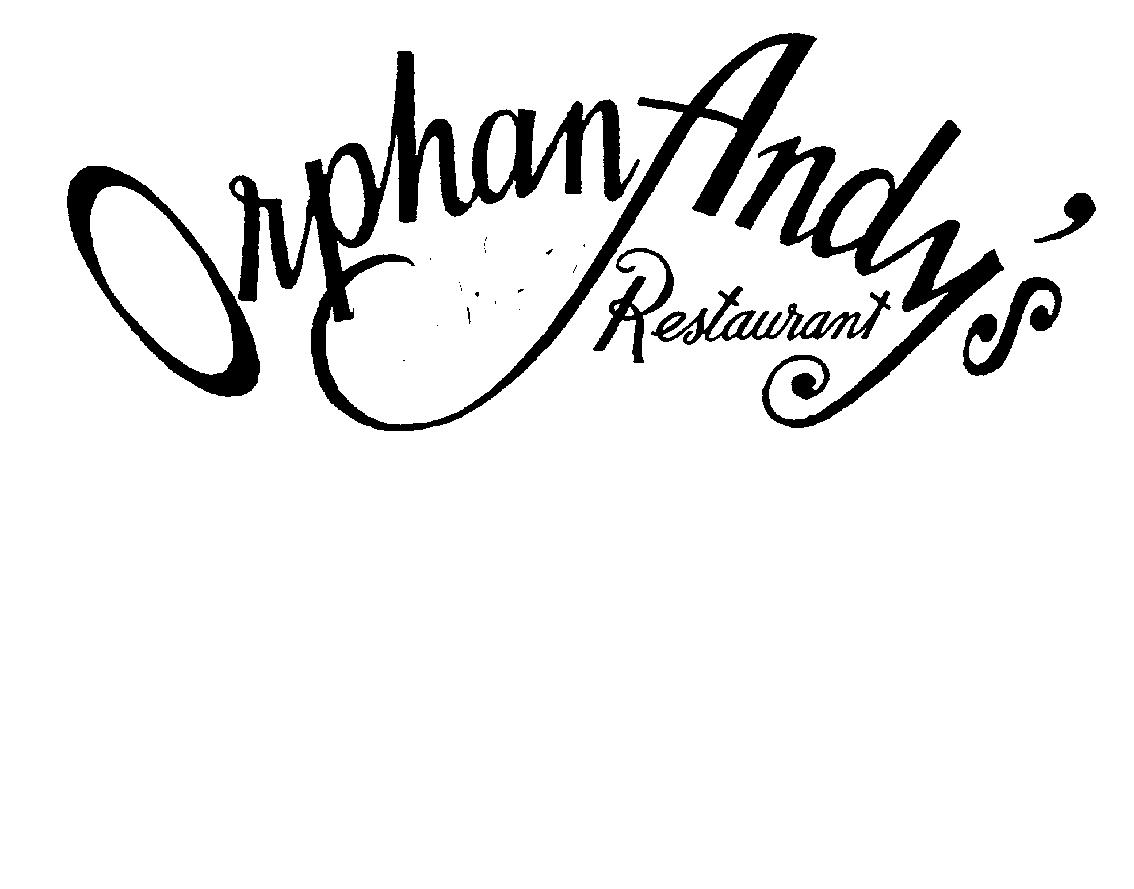



<< Stonewall From page 1
Timothy Leonard, northeast program manager for the National Parks Conservation Association, an independent, nonpartisan membership organization dedicated to advocacy on behalf of the National Parks System, issued a statement.
“The National Park Service exists to not only protect and preserve our most cherished places but to educate its millions of annual national park visitors about the inclusive, full history of America,” Leonard stated. “Erasing letters or web pages does not change the history or the contributions of our transgender community members at Stonewall or anywhere else. History was made here and civil rights were earned because of Stonewall. And we’re committed to ensuring more people know that story and how it continues to influence America today. Stonewall inspires and our parks must continue to include diverse stories that welcome and represent the people that shaped our nation.”
Mark Segal, a gay man and Stonewall pioneer, stated that history cannot be erased.
“The spirit of Stonewall means to be visible and fight back against oppression,” stated Segal, who is publisher of Philadelphia Gay News. “You cannot
“I have not experienced the ‘knife fight in the phone booth’ everyone says second floor is,” Bonde said, referring to the floor where the offices for the mayor and Board of Supervisors are located.
“I’m not naive that won’t necessarily happen, but I feel we’re in this moment (where) we have big forces outside of San Francisco that are very concerning, and this moment in time and the vibe inside the city and inside City Hall is we just want things to work and go forward and jointly work together on things. I think this is a moment in time; we should lean into that.”
Those forces outside San Francisco include Republican President Donald Trump and his administration. But liberals like Mandelman are committed to fighting the president’s agenda in a different way than during Trump’s first term in the White House.
“We will resist where we need to, but San Francisco is not going to lead the Resistance,” he said, referring to the political movement that protested Trump’s first term.
“It’s not a task we are remotely capable of taking on,” he said, adding that though the city will focus on saving “what we can of the American republic,” this will be done “with other cities, states, and city attorneys.”
If Democrats want power, Mandelman said, they have to win voters.
“The agenda we do need to have –
As the Bay Area Reporter previously reported, alcohol sales for public consumption were technically not allowed at the 50th annual Castro Street Fair last October because the fair didn’t have a permit to do so (like the Folsom Street Fair did), and was not an entertainment zone. That could change this year.
Representatives of the fair didn’t return a request for comment for this report.
Mandelman noted, “The annual Castro Street Fair and recently-
Editorial
From page 6
All of these anti-trans actions taken by Trump and his administration perpetuate discrimination, and it likely will be courts that determine which policies stand – we would argue that all of these orders must be halted and reversed. The removal of trans participa-
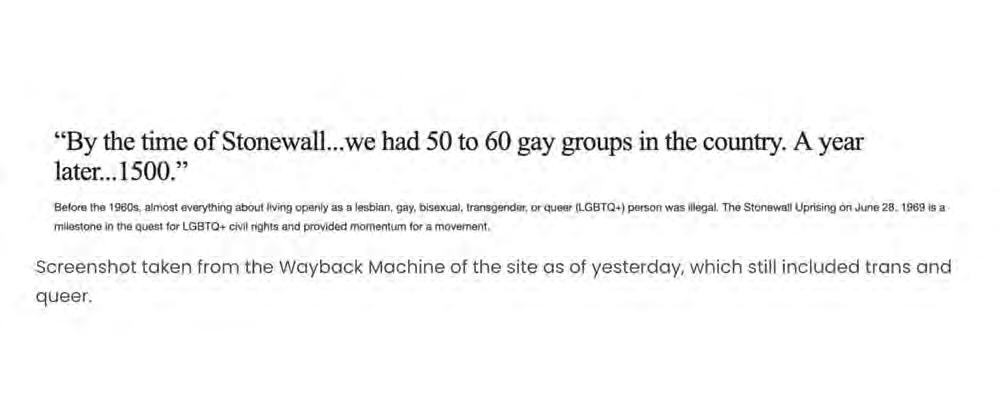
Screenshot taken from the Wayback Machine of the Stonewall site as of February 12, which still included “trans” and “queer.”
erase the history of Stonewall by erasing a letter. You cannot erase trans people by erasing a letter. “This petty, vindictive action is an attempt to not only erase trans people from public view, but also the entire LGBT community. Stonewall, including all of us in the LGBT community who fought back that historic night and have continued to fight for 55 years, cannot and will not be erased. We will continue to fight, we will continue to be visible and persevere, and I urge all in our community to remember this day as the beginning of the second Stonewall rebellion.”
and people are sick of hearing me say this – but the most important thing for a blue city like San Francisco to do is show such a place can be effectively governed, and that there is not an inherent tension or, if there is, we are going to resolve it in advancing the values that define this place and delivering the basics.”
Those basics?
“Safety, cleanliness, and an economic climate in which people try to pursue their dreams,” Mandelman said.
Matt Donohue, a bisexual man and attorney who is Alice’s policy committee co-chair, said at the event that, “The person in the White House is a huge problem. There will be a lot of opportunities to engage, to discuss resistance to the assault he is imposing on our trans community, to the assault he is imposing on our immigrant community ... to the assault he is imposing on our mental health every single day.”
But nonetheless, “Good government in San Francisco is important to combatting the Trump administration, and the things they are doing,” Donohue continued.
Delivering basics
The leaders of America’s big cities are anxious to address structural issues like crime and housing – and perhaps no city has taken the brunt of criticism in recent years more than San Francisco. Mandelman agreed with New York Times commentator Ezra Klein that “liberalism does tend to grind down the achieving of the underlying functions,” in Mandel-
established Castro night markets are examples of events that could benefit from the establishment of an entertainment zone, and could, in turn, benefit local bars and restaurants. We anticipate there will be other ways to put entertainment zones to work for the neighborhood’s restaurants, residents and small businesses as well.”
There are currently three entertainment zones in San Francisco – on Front Street in the Financial District, Thrive City by the Chase Center, and Cole Valley in District 8, which was approved by the supervisors at the February 4 meeting.
tion from the Stonewall National Monument site is different, and more dangerous because there is no easy recourse under this president. It is just one more example of the U.S. sliding into an autocracy like Hungary, where strongman Prime Minister Viktor Orban has dismantled institutions and taken control of the media, as the Guardian pointed out in a recent article. (https://www.the-
Ben Garcia, a gay man who is executive director of the New York City-based American LGBTQ+ Museum, also issued a statement.
“The record is clear: from the start of the modern-day LGBTQ+ rights movement in the 1960s up to today, transgender people have been the heart of the fight for equality,” stated Garcia. “As a museum of American history we will not stand for this attempted erasure of transgender people from the Stonewall National Monument site – LGB does not exist without T and Q.”
man’s words, because procedures meant to make government and society better end up backfiring to hobble institutions.
“One of the reasons we have this blue city, blue state problem is that if you’re an ambitious politician, ambitious not only for yourself but for your agenda to make the world better ... you wouldn’t have come into it thinking ‘what can I get rid of?’” Mandelman explained.
“One has to make their mark in solving all of these problems, and that all involves a law, a change, a new requirement,” he added.
As requirements stack up, the gears of government get slower. But cutting red tape isn’t so easy, he said, because that involves “abandoning something important to someone at some point, and still might be important to them, might be important to some group.”
As an example of this predicament, Mandelman discussed the 2023 repeal of Chapter 12X of the city’s administrative code, which prohibited city employees from traveling to, or doing business in, states that had anti-LGBTQ laws. The chapter was later expanded to cover states with anti-abortion laws and those that abridged voting rights.
Initially “people felt pretty good,” about it, Mandelman said. But, by the time of its repeal, the city’s Chapter 12X policy had grown to cover some 30 states, which critics had lambasted as being too costly and ineffective in bringing about any progressive changes in those states.
“If I was an African American lesbian
The Office of Economic and Workforce Development will work with the Castro Merchants Association to designate events for the zone, according to a news release from Mandelman’s office.
“The Castro Upper Market Entertainment Zone is an amazing opportunity for the bars and restaurants in our community to more fully participate in all the activities happening in the Castro,” Terry Asten Bennett, a straight ally who is president of the association, stated. “In a struggling economy we need to use every tool we have to help our businesses survive and thrive.”
guardian.com/us-news/2025/feb/07/ trump-viktor-orban-electoral-autocracy) (Trump is even attempting to control the media by suing networks. ABC settled a lawsuit for $15 million, a suit against CBS is ongoing. He’s banned the Associated Press from the White House press corps because the news service will not call the Gulf of Mexico the Gulf of America, and possibly because AP’s style guide,
SF site recognized; exhibit temporarily removed in Richmond
As the B.A.R. reported, on January 27 the building at 101 Taylor Street in San Francisco was added to the National Register of Historic Places. The Tenderloin District building was listed without fanfare last month, with the news of the national recognition reaching local advocates earlier this month.
The address was where one night in August 1966 an angry drag queen patronizing Gene Compton’s Cafeteria housed in a ground floor commercial
entrepreneur owning a furniture factory in North Carolina, and I wanted to sell my union-made furniture to San Francisco, I couldn’t do it,” Mandelman explained. “It also meant our bidding pool was reduced. We were certainly paying a markup because we had a much smaller pool. So I was able to get the studies done and repeal that, but it took a long time.”
Two years to be exact, Mandelman said, which portends badly for future bureaucratic reforms.
“We need to do that at scale over and over,” he said, giving another example about repealing a 2019 law that has not yet been enforced regarding frontage requirements for local businesses.
While “I don’t think we want to eliminate everything,” the city needs to be “somewhere between where we are now and a system that has no social priorities,” Mandelman said.
Asked if she could tackle a single issue in the bureaucracy, Bonde said she’d tackle “the morass of permitting.”
“I think the dysfunction there is one of the main things, aside from the condition of our streets, that hurts the public’s faith in government,” she said.
Nonetheless, the Lurie administration so far has had the city’s fentanyl crisis as its No. 1 priority. As the Bay Area Reporter reported last week, the board granted Lurie emergency powers to address the fentanyl crisis, including expedited hiring, firing, and treatment and shelter capacities.
Bonde thanked Mandelman for his help on the fentanyl ordinance.
Bars are similarly enthused – saying that it could represent a critical lifeline.
“I’m excited by the potential opportunity this legislation could provide the neighborhood,” Lookout owner Chris Hastings stated. “Never in my two decades of running a business in the Castro has it been harder to survive. This legislation could help play an important part in a long overdue neighborhood revival. The world at large still thinks of the Castro as a queer mecca; but we haven’t, as a neighborhood, lived up to that reputation as of late, and nightlife will play a key role in any future revival.”
which hundreds of outlets use, has a thorough section on transgender issues, including gender-affirming care, which Trump despises.) There are small signs of hope here, as not all trans content is being erased – at least not yet. We recently reported on the San Francisco site of a protest by transgender people against police being added to the National Register of Historic Places in late Jan-
space reportedly threw a cup of hot coffee in the face of a police officer as he tried to arrest her without a warrant. The exact date of the altercation has been lost to time. But the incident sparked a riot between trans and queer patrons of the 24-hour diner and cops, as detailed in the 2005 documentary “Screaming Queens” by transgender scholar and historian Susan Stryker, Ph.D. Meanwhile, in Richmond, California, the Rosie the Riveter WW II Home Front Museum last month had removed an LGBTQ history-related exhibit, but then returned it. According to Oaklandside, a volunteer was under the understanding that an official order had been given January 23 to take down the exhibit, a series of three panels discussing the history of the LGBTQ community in the Bay Area during World War II. The outlet reported that a spokesperson for the National Park Service said the exhibit is up. While the words “transgender” and “queer” and the LGBTQ acronym were on the site February 13, those had been replaced with “LGB” by February 18. t
This story was first published on News is Out, (https://newsisout. com/) a collaboration of LGBTQ publications of which the Bay Area Reporter is a member. The B.A.R. contributed reporting.
“It was a great collaborative process,” Bonde said. “We know we’re going to be judged by the situation on the streets in the next year, so the board was willing to say, ‘yeah, go for it.’”
Mandelman said that there might be reforms to city departments for San Franciscans to vote on in 2026 – but he was clear that it would be the result of a collaborative process, distinguishing it from Proposition D, a 2024 measure to cut city commissions that failed.
“Have the people who don’t agree with each other fight it out a little bit and see what we can come up with to find a better way of structuring government,” Mandelman suggested.
But dealing with wrangling city departments isn’t just a statutory matter, Bonde said.
“Getting these departments on the same page – most of that, honestly, is social-emotional work in some cases,” Bonde said. “Why doesn’t MTA [San Francisco Municipal Transportation Agency] talk to HSH [Homelessness and Supportive Housing]? What is so hard about that?”
Asked what her measure of success will be, Bonde said, “That we’ve chosen the hard fix that fixes it for good rather than choosing the easy fix that makes people feel good.”
As for Mandelman, he answered, “That we got it to a better state than we found it.”
“I’m a passionate incrementalist,” he said. “I think the world gets better a little bit at a time.” t
The zone would run along 18th Street between Diamond and Sanchez streets, Castro Street between 19th and States streets, Market Street between Collingwood and Church streets, Church Street between 14th and 15th streets, 14th Street between Belcher and Landers streets, and Noe Street between Beaver and Market streets.
The earliest the zone could appear before the supervisors’ land use committee is March 10, unless the 30-day rule is waived, Mandelman legislative aide Anh Ha told the B.A.R. t
uary. That would be the 1966 Compton’s Cafeteria riots that took place at the site of the old diner at 100 Taylor Street in the Tenderloin. It’s believed to be the first federal recognition of a historic site specifically because of its connection to trans history.
But that’s small comfort, as the erasure that has occurred is only the beginning. That should alarm all of us. t

by David-Elijah Nahmod
“Iwas born, and they took a picture,” Liza Minnelli says in Bruce David Klein’s superb new documentary, “Liza: A Truly Terrific Absolutely True Story.” The star was referring to the pressures that come with growing up in the Hollywood spotlight.
The daughter of film director Vincente Minnelli and showbiz legend Judy Garland, Liza has lived in the public eye almost since birth. As a teenager she performed with her mother, going on to carve out her own unique persona. Liza became a star in her own right, winning four Tony Awards, an Oscar, an Emmy, and two honorary Grammys. She has lived quite a life.
Klein’s film begins with the death of Garland,
which affected Liza deeply. She and her mother loved each other dearly, though there were some rifts in the silver lining. When the two performed together a few years before Garland’s death, Liza brought the house down. When they performed a duet later in the show, Garland pushed Liza’s microphone closer to her face. Viewers of the documentary will get to see footage of this. Apparently, there was some jealousy on Garland’s part.
“It wasn’t a load of laughs being Judy Garland’s daughter,” Liza says late in the film, referring to Garland’s substance abuse issues and suicide attempts. The film is unflinchingly honest as it deals with this and with Liza’s own substance abuse issues.
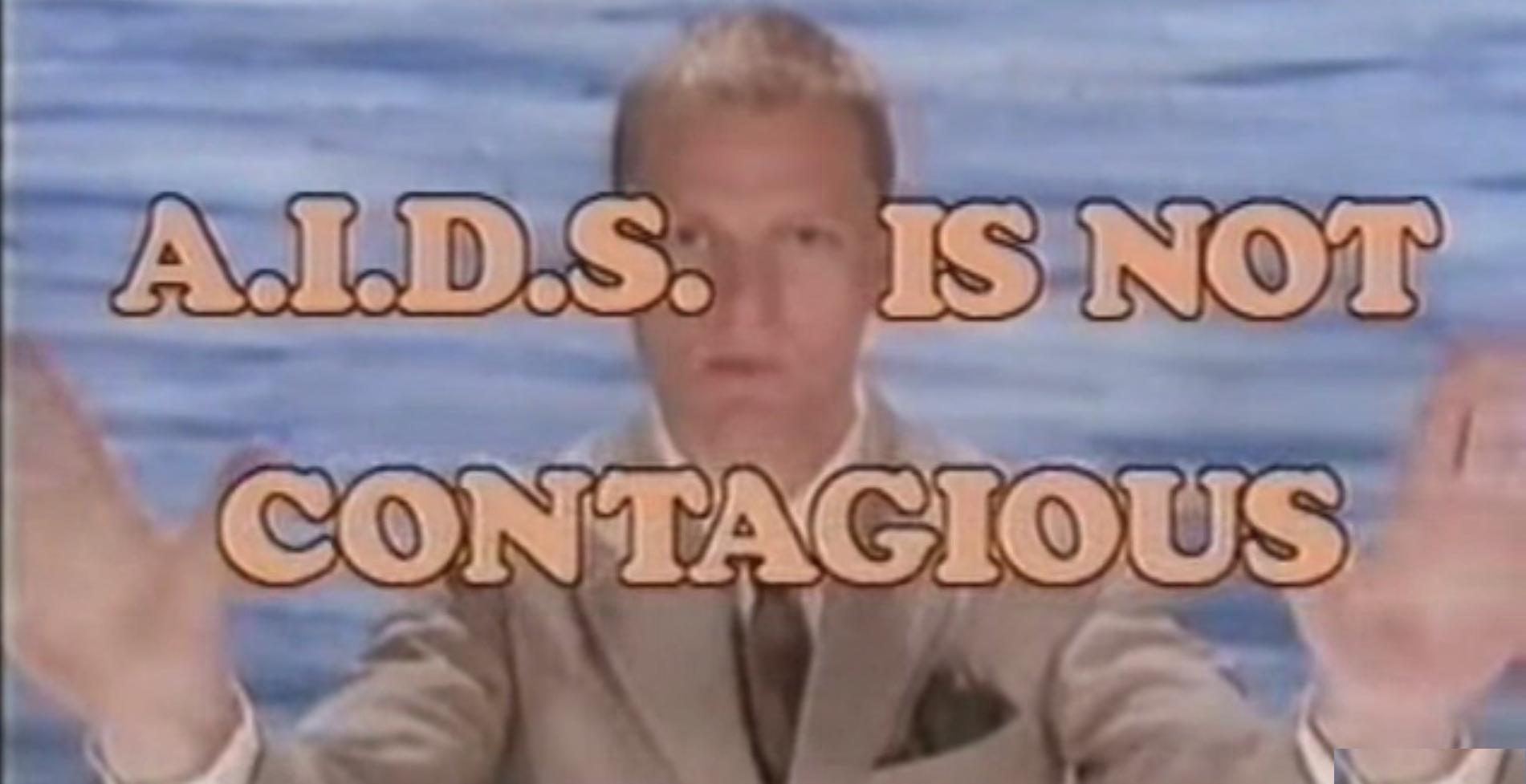
by Michael Flanagan
Astonishingly, Matthew J. Jones “How to Make Music in an Epidemic: Popular Music Making During the AIDS Crisis, 1981–1996” is the first academic book on pop music’s response to AIDS before effective AIDS drugs. There are reasons for that (more on that later), but it’s a rich topic for research. Jones provides a fascinating history which sets a high bar for future books.
Diverse approaches
The title refers to the 1983 booklet “How to Have Sex in an Epidemic: One Approach,” coauthored by Michael Callen, subject of Jones first book “Love Don’t Need a Reason: The Life and Music of Michael Callen” (2020). Callen had a huge impact on Jones and is one of the people this book is dedicated to. Jones acknowledges this isn’t a comprehensive study and that there are other papers and books about AIDS and music, many of which are cited here. This book analyzes several works and what they reveal about the era. It cites many works readers can follow up on, like Fred Maus’ writing on references to AIDS in the works of the B-52s and the Pet Shop Boys.
Avant-garde works by Diamanda Galás, Laurie Anderson and Patti Smith are mentioned (Jones lauds Galás’ work as “one of the most sustained musical engagements with the epidemic”) and popular works by Prince (“Sign o’ The Times”), Joni Mitchell (“Sex Kills”) and Janet Jackson (“Together Again). A wide variety of music is discussed and for those wishing to explore the music of the era it provides amazing documentation.
The introduction offers a variety of music dealing with AIDS from this era. These includes LGBT musicians like Lynn Lavner’s “Such Fine Young Men” (1983), Joe Bracco’s “Friend in My Pocket”(1991), Romanovsky and Phillip’s “Living with AIDS” and “Be on the Safe Side” (1988) and mentions of Callen, the Kinsey Sicks and the Flirtations.
The five chapters in the book are “Palimpsests” or cover songs, “Intertexts” works which quote other works, “Pedagogies” that educate the listener, “Conspiracies” songs which engaged or espoused conspiracy theories and “Testimonials” songs by musicians about the epidemic.
Palimpsests were the first musical responses to AIDS. When people started dying some songs were repurposed for memorials.
“Bette Midler’s “Friends” (1972) predates the AIDS crisis by a decade, but when the first waves of illness and death struck gay men, who are legion among Midler fans, that song took on a new meaning. To riff on an influential essay by Walter Hughes, lines like “I had some friends, but they’re all gone. Something came and took them away” seemed to be coming true”” Jones analyzes three works used to benefit AIDS research: “That’s What Friends Are For” (1985), Coil’s reworking of “Tainted Love” (1985) and “Red, Hot + Blue” (1990), with contemporary artists’ versions of Cole Porter songs.
“That’s What Friends Are For” was originally recorded by Rod Stewart in 1982. The version by Dionne Warwick, Elton John, Stevie Wonder
by Jim Gladstone
“Back to the Future: The Musical” redefines the concept of a star vehicle. The production’s primary draw seems to be the DeLorean sports car-turned-time machine that’s featured in a couple of nifty special effects-filled scenes (Lighting by Tim Lutkin and Hugh Vanstone; video by Finn Ross; illusions by Chris Fisher).
Prior to last Thursday’s opening night at the Orpheum Theatre, where the show’s national tour is parked through March 9, audience members jostled to take photos with a real vintage DeLorean stationed beneath the marquee. (Post-performance, I saw no one lingering by the stage door hoping to meet the production’s human cast members.)
Valuing movie nostalgia and theme park thrills more than thoughtful dramaturgy or thespian skills, the show frequently feels like it’s idling between its two big automated action scenes. Rather than fueling the plot, most of the musical numbers feel like detours, adding little but length to what ends up being a two and a half-hour ride.
Given that there are perhaps 12 minutes of flying car hijinks, “Back to the Future” delivers shitty shitty bang for your entertainment buck.
Time keeps on slipping
Much of the humor in the original “Back to the Future” film came from its clever contrasting of contemporary teenagers and the teens of the 1950s.
Plot refresher: Sixteen-yearold Marty McFly (Lucas Hallauer) accidentally crashes the DeLorean,
Music and AIDS
From page 11
and Gladys Knight garnered a lot of attention and hit the top of the Billboard charts. The song raised funds for AmFAR and became the number one song of 1986.
Coil’s “Tainted Love” predated “That’s What Friends Are For” by a few months and benefited Terence Higgins Trust, the first UK AIDS charity. Unlike “That’s What Friends Are For” and “Red, Hot + Blue” this video directly addressed AIDS, telling the story of a PWA dying from the disease (with Marc Almond appearing as the angel of death).
Jones analyzes videos from the “Red, Hot + Blue” project. David


souped up by his nutty professor pal Doc Brown (Don Stephenson), three decades in the past and becomes an inadvertent interloper in his own parents’ high school courtship.
But as any time-travel afficionado will affirm, “contemporary” is only temporary.
Rather than genuinely rejuvenating their intellectual property by shifting their story’s time periods forward, Bob Gale (who hews close to his own screenplay in the musical’s book) and Alan Silvestri (composer of the film’s score and, in collaboration with Glen Ballard, the show’s original songs) opt for fossilization.
Byrne’s “Don’t Fence Me In” features a variety of faces “establishing the diverse faces of AIDS.” In Erasure’s video for “Too Darn Hot” Andy Bell is a news anchor with archival video of AIDS protests. For “So In Love” k.d. lang portrays a caregiver to an unseen PWA, evoking the role of lesbian caregivers in the epidemic.
Mourning muses
“Intertexts” addresses works “that combine familiar works associated with loss, mourning, and the celebration of life with newly composed music.” Tori Amos’ “Not The Red Baron”(1996), Madonna’s “In This Life”(1992) and “I’m His Child” from the film version of “Angels in America”(2003) are analyzed. In Amos’
Which means “Back to the Future: The Musical” needs to back up further than the movie did. Instead of being about now and then, it’s about then and even thenner.
The 1950s, perma-pressed into pop culture by “Happy Days” and “Grease,” fare better than the ’80s, which are nebulously represented by lots of Lycra, big hair, and songs garnished with squiggly neon synth sounds that have since been effectively banned from pop music.
The ’80s scenes are also so thinly written that audiences will have no sense of investment in Marty’s relationship with his girlfriend Jennifer
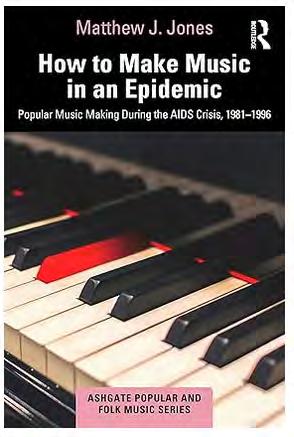
(Kiara Lee) or his barely sketched dreams of becoming a rock star.
“Back to the Future,” the movie, was made for a target audience of 1980s teenagers, exalting in their culture while poking gentle fun at their parents’ era. But the musical makes the ’80s look lame, appealing neither as a present-day past or a ’50s future.
Mixed updates
The show does feature one undeniable comic gem: The ’50s scene in which Marty’s then-teenage mother-to-be, Lorraine Baines (Zan Berube, a perfectly calibrated comedian), tries to seduce her time-traveling son.
In the film, much of this scene’s punch hinged on Lorraine’s assuming, based on the waistband of his underpants, that her new crush’s name was Calvin Klein (Imagine an updated version, in which his briefs clued her into his being a Nasty Pig!).
That bit still works, but the musical amps up the yuk-yuk-ick factor of the ambient incest humor, with three pink-clad chorines appearing out of nowhere to sing back-up for Lorraine on a swoony “Pretty Baby.”
It’s delectably creepy, as if John Waters had donated an excised scene from “Hairspray.”
The Doc Brown character, played with antic battiness by Christopher Lloyd in the film, is here turned into a flimsy bridge between stage and screen. Don Stephenson plays the role with winking vaudevillian schtick that, in musical numbers, is accompanied by a phalanx of leggy dancers.
Stephenson/Brown regularly breaks

song, which refers to red ribbons in the lyrics, Jones hears Chopin’s funeral march.
“In This Life” samples Gershwin’s



“Prelude for Piano No. 2” and was inspired by the deaths of Madonna’s friends Martin Burgoyne and Christopher Flynn. “I’m His Child” originally appeared in “Say Amen, Somebody!” (1983).
“Pedagogies” shows how musicians educated the public about AIDS. Some songs were from the gay community, like Callen’s “How to Have Sex in an Epidemic” (1983) and Automatic Pilot’s “Safe Livin’ in Dangerous Times” (1984).
Others come from pop artists like the Village People, who released “Sex over the Phone” (1985) and Jermaine Stewart’s “We Don’t to Take Our Clothes Off (To Have a good time).”
Some were geared towards wom-
the fourth wall to raise skeptical eyebrows, shrug, and shake his head in bewilderment at the silliness he finds himself in the midst of. It’s a skillful performance, but it’s hard not to think of him as an avatar for director John Rando, rolling his eyes at the audience and wondering how he got into this mess. Most of the jokes and lots of the dialogue are directly lifted from the screenplay, giving the whole show a bit of a slavish karaoke vibe.
Retro onerous
Amazingly, the most problematic, long-criticized scene from the film is left intact. The woozy music at a 1955 high school dance is provided by an all-Black combo specializing in slow doo-wop and Johnny Mathis style jams.
It’s jolted to life only when Marty, a classic California Caucasian, takes the stage and busts out a blues-rock rendition of Chuck Berry’s “Johnny B. Goode.”
Does the fact that Gale, Silvestri, and Ballard have shoehorned a barn-burning gospel tune into the show elsewhere (“Gotta Start Somewhere,” charismatically delivered by Catreze Tucker, playing minor Black character Goldie Wilson) somehow compensate for this?
Not at all. It underlines it. Overall, “Back to the Future” doesn’t look so bright.t
‘Back to the Future: The Musical,” through Mar. 9. $60-$254. Orpheum Theatre, 1192 Market St. www.broadwaysf.com www.backtothefuturemusical.com
en, like Gwen Guthrie’s “Can’t Love You Tonight.” One, “Let’s Talk About Sex” by Salt-N-Pepa, made the top 20 of Billboard’s charts (and was later reworked as “Let’s Talk About AIDS”).
The chapter hits its stride discussing the “Red Hot + Country” project. Jones reveals it took two years for the project to happen and discusses the reticence of the musicians:
“Whereas its predecessors included explicit messages about safe sex, drug use, HIV testing and then current treatments, “Red Hot + Country” deftly two-steps around the very words “HIV” and “AIDS.” This silence in a Red Hot production is remarkable.”
Useful idiots
“Conspiracies” is aggravating but useful. Front and center is the Foo Fighters concert in Los Angeles in 2000 that featured AIDS denialist Christine Maggiore (1956 – 2008) from Alive & Well AIDS Alternatives, which pushed AIDS denialism.
Conspiracy theories in hip-hop include “Meet the G Who Killed Me” by Public Enemy which quotes from conspiracy theorist Dr. Francis Welsing (claiming AIDS was first described in 1969) and includes homophobic lyrics like “Man to man, I don’t know if
See page 13 >>

by Adam Sandel
We’ve all had crushes and transformative moments of love. Now nine diverse writers will share their stories and bare their souls in “Crushing,” a live monologue show which will have its West Coast premiere on Thursday, February 27 and Friday, February 28 at the Bayfront Theater in San Francisco’s Fort Mason.
Helmed by San Francisco’s Carly Steyer and Megan Calfas, and executive produced by Rosario Dawson, the show will include performances by nationally acclaimed queer Bay Area writers Garrett Schlichte and Sam Sax. In a recent phone interview with the Bay Area Reporter, each of them shared what brought them to “Crushing,” and what they plan to reveal on stage.
Cooking up stories and entrees
Garrett Schlichte’s writing has been featured in The New York Times, The Washington Post, Jezebel, Teen Vogue, Slate, and The Advocate, among other publications. An accomplished chef, he was a top three finalist on Freevee TV’s “America’s Test Kitchen: The Next Generation.” He now serves monthly pop-up dinners at the Virgo Supperclub in San Francisco.
Born and raised in Florida, Schlichte has lived in San Francisco for the past five years, having started his writing career in Washington, D.C.
“I started writing when I was very young,” he said. “I went to school for journalism, and I did film and
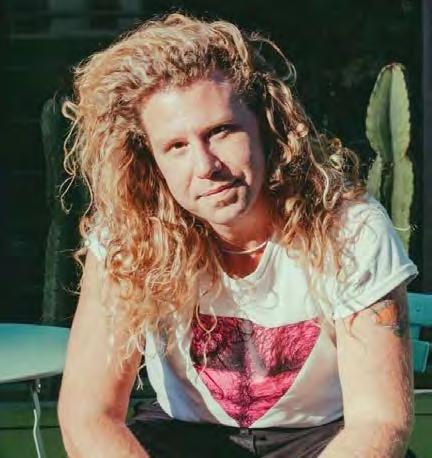

TV reviews and contributed to a dating column while in D.C. But San Francisco is my favorite place in the entire world.”
A writer friend in the Bay Area sent him a post about the “Crushing” casting, so he applied, sent in a video, and was chosen.
“I’ll be doing a piece about a breakup,” he said. “It’s a story about the transformation I went through with an ex-partner. The theme is sometimes it’s okay to change who you are for someone you’re in love with. I found myself making some real changes, and ended up becoming a better version of myself. It’s a story that only could have happened in San Francisco.”

voices
they can; from what I know the parts don’t fit.”
The chapter wraps up discussing the 1996 Red Hot hip-hop album “America Is Dying Slowly” which transmitted misogyny by excluding female artists and tracks blaming women like “No Rubber, No Backstage Pass” and “Stay Away from the Nasty Hoes.” Add inclusion of conspiracy theories about the origins of AIDS and this album was one hot mess.

The most powerful chapter is “Testimonials” which includes songs by people with AIDS, HIV-negative people speaking for the HIV-positive (“ventriloqual testimonials”) and third-person testimonials. Jones notes few musicians were willing to own having AIDS in the ’80s and 90s. Those who did included Michael Callen, “Guiding Light” actor Keith Christopher whose posthumous album “Naked Truth” was released in 1998 and country musician Doug Stevens, whose song “HIV Blues”
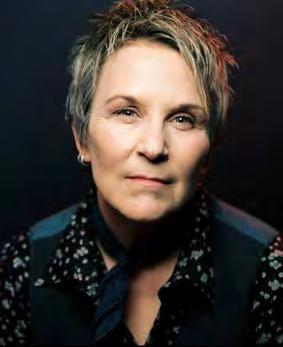
Schlichte has performed his work at the San Francisco reading series
“Happy Endings;” he recently signed with a literary agent; and he’s currently working on a collection of essays.
“It’s interesting to work in both writing and cooking,” he said. “Cooking is fleeting. Once you serve people, it’s gone, but writing lasts forever. Both are about feeding people and making a connection. Cooking has taken up a lot of my time lately, so it’s nice to put down the spatula for a bit.”
Poetry, plaudits and pigs
Sam Sax is an Oakland-based poet and novelist who identifies as queer, Jewish, and nonbinary. They’re the au-
was on his 1993 album “Out in the Country.”
What made ventriloqual testimonials powerful was well known musicians singing about people with AIDS. This helped spread both empathy and information. One example is Elton John’s “The Last Song” from 1992 about the reconciliation of a man dying of AIDS with his father.
Another is lesbian Mary Gauthier’s “Goddam HIV” (1997) in which Gauthier inhabits the voice of a man dying from AIDS. The song captures the sadness, loneliness and frustration of PWAs from this era simply and directly. One negative example is Reba McEntire’s 1994 song “She Thinks His Name Was John,” in which a woman contracts AIDS from a onenight stand whose name she can’t remember. The song indulges in victim-blaming and stigmatizes the woman.
Pricey resource
“How To Make Music in an Epidemic” is packed with information about music and pop culture. As someone who lived through this era, I found it extraordinarily informative. It is a welcome addition to both historical and pop culture books.
However, there are a few things about it being an academic title that bear discussing. The book is written with musicologists, musicians and music historians in mind, so it is an academic text. Even so the vast majority of the book is accessible to the lay reader. Jones mentions that he was actively discouraged from writing on this topic in the introduction:
“A professor I knew and admired in graduate school once worried that writing about the topic of music and HIV/AIDS would be career suicide. ‘You’ll never get a job,’ they said and expressed their opinion that I ought to write about something, anything else. I did not take their advice.”
It’s upsetting that this is happening more than 40 years into the epidemic, but explains why it took so long for a book on this topic to appear. Since the generation who initially faced AIDS is now aging it’s timely for this to be discussed now.
drove around, performing poetry at punk houses, pizza places, and open mics. I joined the poetry slam world in the Bay Area when I arrived in San Francisco in 2010.”
Sax has published three books of poems, and their first novel was published in August.
“My last poetry book, ‘PIG,’ is about pigs – how we say men are pigs, cops are pigs, and we use the term ‘pig bottom.’ It’s about gender construction and how we conceptualize pigs in our culture. The novel is a queer coming of age story.”
Sax also runs a monthly open mic. For information on dates and venues, follow their Instagram account. For “Crushing,” Sax is writing a new piece about obsessive desire, and another piece about being in an eight-year partnership.
thor of “Yr Dead,” which was longlisted for The National Book Award, and “PIG,” named one of the best books of 2023 by New York Magazine and Electric Lit.
They’re a two-time Bay Area Grand Slam Champion, with poems published in The New York Times, The Atlantic, Poetry Magazine, and elsewhere. An Interdisciplinary Arts Lecturer at Stanford University, Sax has a long history of performing in front of an audience.
“I was a theatre kid, and I used to devise monologues and pieces with my friends at Oberlin College,” Sax recalled. “I lived in a car with three of my friends after college, and we
The major problem with the book, however, is the price. As an academic title from Routledge, it’s well beyond the budget of most readers at $190 in hardcover (although it is available for $161.50 from the publisher and the ebook is considerably less at $33.99). The price is a considerable barrier and will also prevent the book from being acquired by libraries, all the more shame, as it is an important book.t
Matthew J. Jones’ ‘How to Make Music in an Epidemic: Popular Music Making During the AIDS Crisis, 1981–1996,’ Routledge Press www.routledge.com
“We’re both queer, polyamorous, and nonbinary, so it’s about how to reinvent models for how we care for each other. It’s about navigating a different language around our love.”t
‘Crushing,’ $31-$50, Feb. 27 & 28, 7:30pm, Bayfront Theater, Fort Mason, 2 Marina Blvd, Building B, Floor 3. www.crushing.show www.garrettschlichte.com www.samsax.com

Model looks 6’ 150# 27yrs, 8” uncut beautiful tight yummy ass. Smoky sexuality erotic male nympho. Hndsm hedonist. Str8, gay, married men at yr apt, hotel, mansion! Greek god Nick 415-818-3126. Leather fetish fantasy roleplay kink dom sub group scenes mild to wild. Pretty boy with a dirty mind, romantic & unforgettable! $400/hr, $2000 overnight neg.

by Victoria A. Brownworth
We have been in the hospital since January 22. It’s been a very dicey time during which we spent two days unconscious on an assistive breathing device and had liters of fluid drawn off a lung with long needles between the ribs.
This is the first column we have been able to write in this time. That is what cancer does: it robs you of normalcy, energy and your sense of self. It is exhausting. Despite ads for drugs like Keytruda, it is often a full-time job that makes it impossible to live your life as you knew it pre-cancer.
We’ve been blessed to have thousands of people among our 160,000 Twitter/X followers praying for us, from celebrity followers to our dedicated Bay Area Reporter readers. For nearly every day of this hospitalization we have felt exhausted, unmoored and scared as hell. At times we just prayed we would not die.
It is into that lived experience we have been watching two new limited series about women who claimed to have cancer but didn’t. Their stories have left us angry, flummoxed and even betrayed.
Scamalot
ABC’s original docu mentary series (with episodes streaming next day on Hulu) “Scamanda” tells the story of Amanda Riley, California housewife, mother and cancer blogger. It could not be a more captivating tale of charisma, manipulation and greed.



Soon TeamAmanda became a thing with Riley soliciting funds for treatments she said were bankrupting her. Celebrities like Lee Ann Rimes posted their support while others signed onto monthly donations. She was garnering thousands of dollars online at her website as well as in-kind contributions in gifts and services like free daycare for her young children.
But some things didn’t add up and soon an investigative reporter was delving into Riley’s conflicting claims and all the many treatment centers at which she said she was enrolled in cutting edge clinical trials.

Riley created a blog that became tremendously popular in which she posted about her cancer, lymphoma, and her harrowing treatments. She charted every experience, talked about clinical trials, about not being able to even sit up in bed some days, about nearly dying.
It is an utterly compelling story in which Riley posted photos of herself in hospital settings with IVs, with her head shaved and more. She had humor and charm and drew people to her. Riley’s story of a beautiful young woman fighting for her life is mesmerizing. It is easy to see how her blog posts--she has a real facility with language--drew people to her.
Everyone wanted to be part of TeamAmanda and help this courageous fighter survive a devastating diagnosis. Riley also belonged to a mega church, the members of which literally threw money at her after she talked about her experience and how it brought her closer to God.

Yet accusing a noted cancer patient of faking her cancer wasn’t an easy task. It would take time to peel back the layers of deception and greed and land in a wire fraud case against her and her husband. We can’t wait to see what happens next.
Built on a lie Netflix’s stellar and maddening new original series, “Apple Cider Vinegar” just dropped. In this series Kaitlyn Dever (“Dopesick”) plays Belle Gibson, a powerful internet influencer in the 2010s who claimed to have conquered terminal brain cancer through lifestyle changes and diet.
While Amanda Riley was only asking people for money for herself, Gibson was doing something much more nefarious: She was luring people with cancer with false promises of cures for their devastating diagnoses.
Dever’s Gibson is vividly compelling as she builds a retinue of followers who are themselves desperate to survive their own cancer diagnoses. Her seeming honesty and authenticity about her own survival reveal her as a manipulative charmer. As each of the six episodes announce, “This is a true story built on a lie.”
mark sequin look, director Bob Fosse, who made her a movie star in the film adaptation of “Cabaret, Charles Aznavour (the French Frank Sinatra), and Kay Thompson, who helped build up Liza’s confidence during her early years as a performer.
All of these mentors have passed on, but Klein brings them back to life with extraordinary, previously unseen footage and photos. Liza herself recalls each of them with great fondness in newly shot interviews.
Also included in the film is commentary from some of Liza’s closest friends, like crooner Michael Feinstein and actress Mia Farrow.
“Apple Cider Vinegar” explores Gibson’s narcissism and her traumatic childhood and need for attention. It also delves into her conflicts with and envy of another influencer, Milla Blake (Alicia Debnam-Carey). The main distinction between the two women is that Blake does indeed have cancer, but promotes a nontraditional approach to healing.
Throughout “Apple Cider Vinegar” different players in Gibson’s life and circle weigh in and each one makes the story both more captivating and more convoluted.
Both Riley and Gibson rose to their respective fame at a time when the internet influencer was a new societal character and social media was just taking off. That factors into their prominence and how people were drawn to them and their stories.
These tales of women faking cancer raise so many questions. What was a red flag for us and the close friend of Riley’s who connected with the investigative journalist is that despite myriad posts in which she said she couldn’t even sit up in bed she was so sick, Riley never looked sick. She wasn’t bloated from massive steroids
nor did she have the sickly pallor so many of us have. She always looked pretty and most of all healthy.
What unnerves as “Apple Cider Vinegar” evolves is how these fake cures threaten people’s lives and their possibility of survival. Much as we would all prefer a coffee enema and juicing to chemo and radiation – we had five surgeries in December –the road to survival is not simply a better diet, shots of apple cider vinegar and longer walks. Those things won’t hurt you and many cancer centers incorporate non-traditional alternative medicine like acupuncture, yoga, meditation and dietary changes into their overall plan.
But as “Apple Cider Vinegar” reveals, our fear of cancer is such, we cannot help searching for easier methods to save our very lives. And because we never talk about cancer as a society, the facts of how many of us have it or that a third of those who get it will die are unknown to most Americans.
Our PSA to you is this: 1 in 2 Americans will get cancer and cancer is impacting Americans at younger and younger ages. There are 21 million

Americans with cancer right now. So get tested. Stop smoking and vaping. Don’t drink to excess. Do the Cologuard test for colon cancer. Get a mammogram and a prostate exam. If you are 45 or under, get the HPV vaccine which protects against several cancers in women and men. Do your best to save your life.
Home again
TV is notorious for running PSAs about Black History Month but not providing backup programming. Black stories remain under-represented on network, cable and streaming services.
Into that milieu debuts “Clean Slate,” executive-produced by comedy legend Norman Lear, where trans actress Laverne Cox is once again revealed to be a versatile and highly nuanced performer.
The eight-episode original series developed by Cox and comedian George Wallace for Amazon Prime is a sweet and complex tale of father daughter rapprochement after a long hiatus.
Cox plays Desiree, a trans woman who returns home to small town Alabama after her life falls apart. She will be seeing her father, Harry Slate, a car-wash owner, who is eager to meet with his son after a 23-year hiatus.
But the child who arrives on his doorstep is his transitioned daughter not his son, and so Harry must come to terms with this radical change and find renewed love for his daughter as he had for his son.
No doubt many viewers will raise an eyebrow or two over this scenario as the Deep South has not been a good place for Black trans women or trans people in general. But Cox and Wallace have good chemistry and this is a series well worth watching.
Buzz
The first two episodes of season three of the queer thriller series “Yellowjackets” dropped on Paramount+ on Valentine’s Day. What an amuse bouche it is to have this fabulous series back for another delve into the lives of four women who as teenagers were members of an elite soccer team who survived a plane crash, cannibalism and a “Lord of the Flies” devolution into ferality.
The always fabulous Melanie Lynskey and Juliette Lewis, Tawny Cypress, Lauren Ambrose and Christina Ricci play the adults still coming to terms with what happened in their collective past. It’s well worth watching, but you must watch from the first season.
So, for all the enticements and excitements, you know you really must stay tuned.t
her over the years.
Lyricist Fred Ebb, fashion icon Halston, who created Liza’s trade-
Liza’s sometimes turbulent personal life is also discussed. She was married four times and suffered three miscarriages, which is one of the great tragedies of her life as she always wanted a family. Her first marriage was to performer Peter Allen, a marriage that ended when she found Allen in a “compromising position” with another man. Her last marriage was to David Gest, who mistreated her. Mostly what shines through as

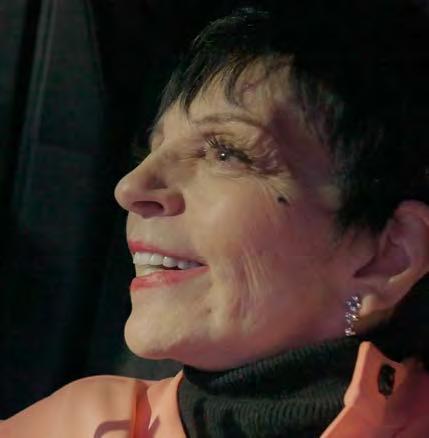
the documentary unfolds is Liza’s extraordinary talent. She embodies the true definition of a star. When she’s on, it’s impossible to look away from her. Klein beautifully captures Liza’s dazzling stage persona, as well as who she is after she
life story for all time.t ‘Liza: A Truly Terrific Absolutely True
103 minutes, opens February 28 at the Roxie Theater, 3117 16th St. www.roxie.com www.zeitgeistfilms.com
by Tim Pfaff
Since we last regarded Stephen Hough in these pages, the out pianist has become Sir Stephen, and his work as a composer has come into its own. He now has more that 70 recordings to his credit, the most recent bridging the span between his work as a soloist and chamber musician and his emerging identity as a composer of consequence.
There’s more than a little sense of homecoming in his latest release, his 2023 Piano Concerto and two solopiano suites (Hyperion). On it, Hough is met by The Hallé (the British orchestra’s name) under the baton of its outgoing music director, Sir Mark Elder, in the concerto –and meets bits of himself in the 2019 compositions ‘fostered by” the pandemic. It was, he says, the erasure of his concert schedule that soon made time and space for his compositions.
This must be seen in context. A long-ago recipient of a MacArthur Foundation “genius” grant, Hough has always been an active polymath. He has seasoned his core concentration on the vast body of music for his instrument with lively, penetrating musical criticism, a poignant memoir (“Enough”), and a highly regarded novel, “The Final Retreat.” And this is not to mention the paintings.
He moves in the ranks of the writers and musicians for whom a long-haul flight is the opportunity for creativity and, crucially for him, productivity. Fans who follow him on social media also enjoy his travelogues, indulging his proclivities as a fine photographer. He entitled a collection of his reflections on music (the industry as well as the repertoire) “Rough Ideas,” which a less modest scribe might have called “Thoroughly Thought Thoughts.” If Hough has any “idle thoughts,” hard to imagine, he’s keeping them to himself.
The challenge for an arts writer at a weekly is simply keeping up. There are certain out musicians, the French early-music wizard Christophe Rousset among them, who are simply so productive that to comment on their every project would require ongoing special editions. These creators and co-creators have daunting performance careers allied and spiced with almost aggressive recording schedules, not to mention the research –and practicing. What emerges behind the


or Beethoven’s Fourth, where the pianist makes an arresting solo entrance before being swallowed up by yet another symphony.
I don’t know why, but I’d be less than candid if I did not say that Hough’s orchestral intro left me impatient for the piano’s arrival. It’s even more puzzling that when the piano does enter, it’s with a cadenza-level fanfare.
There’s an idea out there that the success of a new concerto depends on its being picked up by other virtuosos. But in our time, when most music charts movement from dark to light, that’s a less determinant factor. Will other pianists take up their colleague Daniil Trifonov’s daunting exercise for piano and orchestra?
Time will tell. New piano concertos by Thomas Adés and John Adams have inspired multiple new adherents. Hough’s “calling-card” concerto is a beguiling invitation.
Five not-so-easy pieces
The recording concludes with “Partita,” which poses technical challenges signaled by the Toccata that comes as the last of its five movements. It’s awe-inspiring in a non-distracting way. The Hough faithful would not excuse any departure from the brilliantly playful aspect of his musicianship.
headlines is that other musicians really like working with them, and so do audiences.
The Piano Concerto
In his booklet note, Hough predictably points to the historical keyboardists (Beethoven to Bartok, let’s say) whose concert work was augmented by their own compositions.
His point is that these performers didn’t just add musical composition to the fare but who would have thought it their responsibility to compose as well as play, to make “calling-cards” as all-around musicians.
Here he joins them. The subtitle of his new piano concerto is “The world of yesterday,” recognizing and expanding upon the historical nature of the concerto as a form and, yes, its stars.
Audiences disinclined to subsidize “new music,” fearful of its noise, have nothing to fear here.
The concerto is hardly off the starting block before the words “movie music” occur to the listener. Hough the artistic democrat would not take that as a knock and would have to go no farther than composers Eric Korngold and Bernard Herrmann –and Leonard Bernstein and Dmitri Shostakovich, closer to our day– to cite as fellow practitioners.
Crowd-pleasing is only the icing on these music desserts. Skillful composition always allows for displays of instrumental virtuosity but favors its listeners with music of substance beneath the filigree.
If anything perplexes about Hough’s new concerto, it’s that opening. The orchestra noodles on for several minutes before the piano makes its stealth entrance, prompting the question, Why? This is not, after all, a revisiting of Brahms’ Second Concerto, with its long, symphonic intro,
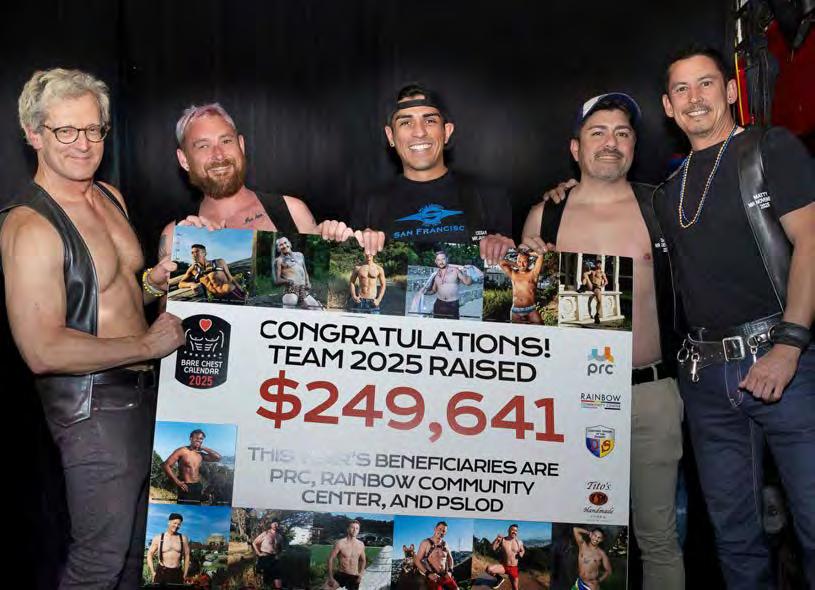
Once underway, the concerto, with its more traditionally aligned resources, scurries along with its own unflagging energy. At its core is a waltz both immediately charming and capable of extravagant elaborations, of the kind heard in Ravel’s “La Valse,” both orchestral and solo-piano versions.
Like the concerto itself, its three movements have titles, “PreludeCadenza,” “Waltz Variations,” and “Tarantella appassionata.” What it accomplishes is nothing less than a charting of the emergence of a distinct artistic profile through an orchestral soup that threatens to drown it. The release into that “passionate devil dance” is palpable, and, perhaps predictably, Hough does not stint on the prestidigitation.
The “Sonatina nostalgica” fulfills Hough’s knack for memoir. Hough composed it for the 70-year-old pianist Philip Fowke, and it reflects the composer’s own growth –literally– from unlikely if promising beginnings to a mature appreciation of paths travelled. It’s sentimental in all the best ways.
Hough’s second keyboard is on an iPad, and his multifaceted writings thereupon have sometimes been eclipsed by the music composed and performed. But his irrepressible intelligence finds some of its finest outlets in the written word, his written word, that is. And Hough’s own words about the Sonatina can stand as a kind of motto for this disc overall: “It deliberately utilizes a romantic musical language of yesteryear.”t
Stephen Hough, Piano Concerto, “Sonatina nostalgica,” and Partita, Stephen Hough composer and pianist, CD and streaming, Hyperion Records. hyperion-records.co.uk






